Affiliate disclosure: This post may contain affiliate links. Please see our Privacy Policy.
Medicinal flowers are a great way to grow homemade herbal medicine, all while brightening up your garden space with colorful blossoms.
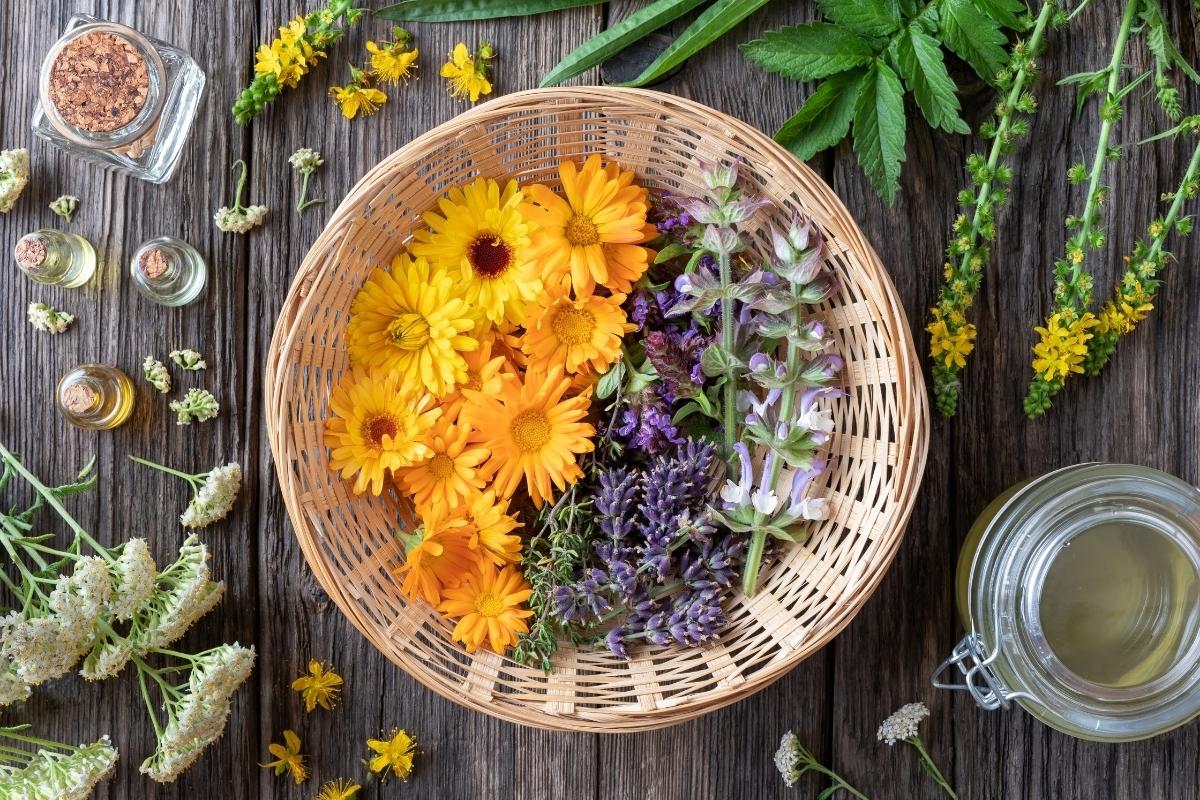
Table of Contents
- Medicinal Flowers
- List of Medicinal Flowers
- Agrimony (Agrimonia sp.)
- Angelica (Angelica Sp.)
- Arnica (Arnica sp.)
- Bee Balm (Monarda sp.)
- Black-Eyed Susan (Rudbeckia hirta)
- Blue Vervain (Verbena hastata)
- Borage (Borago officinalis)
- Calendula (Calendula officinalis)
- California Poppy (Eschscholzia californica)
- Clover, Red (Trifolium pratense)
- Chamomile (Matricaria recutita & Anthemis nobilis)
- Comfrey (Symphytum officinale)
- Cornflower (Centaurea cyanus)
- Daisy (Bellis perennis)
- Dandelion (Taraxacum officinale)
- Echinacea (Echinacea purpurea)
- Elderberry Flowers (Sambucus nigra)
- Evening Primrose (Oenothera biennis)
- Feverfew (Tanacetum parthenium)
- Foxglove (Digitalis lanata)
- Hawthorn Flowers (Crataegus sp.)
- Herb Robert (Geranium robertianum)
- Hollyhock (Alcae rosea)
- Hyssop (Hyssopus officinalis)
- Jasmine (Jasmine officinale)
- Jewelweed (Impatiens capensis)
- Lavender (Lavandula angustifolia)
- Marshmallow (Althaea officinalis)
- Motherwort (Leonarus cardiaca)
- Nasturtium (Tropaeolum sp.)
- Passionflower (Passiflora sp.)
- Peony (Paeonia sp.)
- Pineapple Weed (Matricaria discoidea)
- Queen Anne’s Lace (Daucus carota)
- Rose (Rosa sp.)
- Saint John’s Wort (Hypericum perforatum)
- Self Heal (Prunella vulgaris)
- Tulsi (Ocimum tenuiflorum)
- Valerian (Valeriana officinalis)
- Veronica (Veronica sp.)
- Violets (Viola sp.)
- Witch Hazel (Hamamelis virginiana)
- Yarrow (Achillea millefolium)
- Herbal Disclaimer
- Herbal Guides
Flowers are a beautiful addition to any garden, but some do more than please the eye!
When we adding more flowers to our gardens, my main focus was on edible flowers that will bring my little ones to the yard. They love seeking out sweet fragrant blossoms, and knowing they can safely eat them means we’re all happy.
While doing research on all those useful flowers, I found that they can be even more than beautiful and delicious. Flowers can also be medicinal!
We grow and use a lot of medicinal plants on our homestead, and the medicinal flowers are some of my daughter’s favorite. She has a special affinity for them, and they’re a lot easier for her to remember than the leaves, roots, and bark.
Even as a preschooler she knew that she could run and harvest chamomile blossoms to help her baby brother when teething pains brought tears to his eyes. It gave her a sense of empowerment, and this mama’s not going to turn down anyone going the extra mile to help out.
Many people have an affinity for medicinal flowers, and the showy blossoms are often easier for people to identify and remember than most other medicinal plants. They’re a powerful addition to your herbal medicine chest and a spectacular addition to any garden.
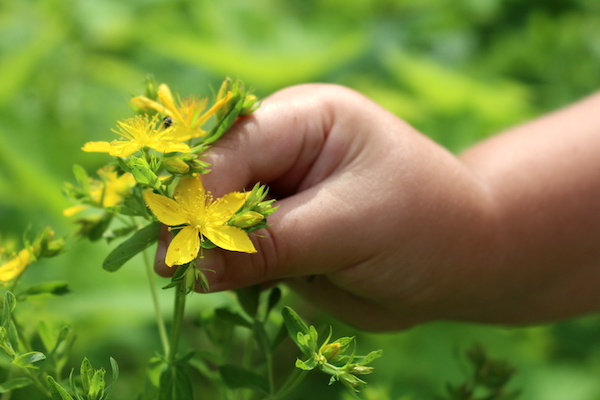
Keep in mind that while many medicinal flowers are subtle, mild, and relaxing, like chamomile and lavender…some are not so gentle. Some have incredibly potent medicinal actions and they shouldn’t be used without consulting a doctor or herbalist. Foxglove is one good example and is listed for informational purposes only. It can be toxic or harmful if used improperly, and should not be used unless under the guidance of a qualified medical professional. Many of these medicinal flowers are for external use only (arnica and comfrey are good examples), so pay careful attention to the appropriate herbal preparations for each plant as well.
Be aware that I am not a clinical herbalist, and this is based on my own research and personal experience using medicinal plants. I do not claim to have the experience that’d qualify me to advise you on your health, and I’m only providing this as a reference to encourage a broader interest in medicinal plants.
This is not meant to be an all-inclusive guide, but instead a starting point to help you further appreciate the medicinal flowers growing all around you. Please use this as a jumping-off point, but always do your own research and verify anything you read with multiple sources. Please consult a qualified herbalist before attempting to use any of these medicinal flowers.
Medicinal Flowers
Most medicinal flowers are also edible flowers, and they can be taken internally as teas, infusions, cordials, and tinctures. Some, however, are only for topical uses and should not be consumed (arnica is a good example). Be sure you understand the proper herbal preparations for each medicinal flower in your garden.
If you’re new to making homemade herbal medicine, I’d suggest taking the herbal preparations mini-course from the Herbal Academy of New England. It’s one of their most inexpensive courses for beginners, and it’ll cover everything you need to know to make more than a dozen different herbal preparations at home.
Much of that same information is covered in their introduction to herbal medicine course and the family herbalist group of courses, but just in a much greater depth.
Often in herbal preparations, herbs are mixed to complement and amplify the medicinal actions. If you’re interested in developing your own herbal formulations, I’d recommend taking this online course in Mastering Herbal Formulations from the Herbal Academy.
I’ve taken all of these courses and they’re informative, inspiring, and artfully presented.

List of Medicinal Flowers
If you’re just looking for a list to help inspire your garden, this list of medicinal flowers covers most of the most common medicinal flowers anywhere. Most grow like weeds and can be foraged in the wild, but they’re still strikingly beautiful.
Others are a bit more finicky in terms of growth habits, but they’re the exception. Most of the well-known medicinal flowers are plants our ancestors harvested in the wild, and then brought into their cottage gardens for both their beauty and medicine.
- Agrimony (Agrimonia sp.)
- Angelica (Angelica sp.)
- Arnica (Arnica montana)
- Bee Balm (Monarda sp.)
- Black-Eyed Susan (Rudbeckia hirta)
- Blue Vervain (Verbena hastata)
- Borage (Borago officinalis)
- Calendula (Calendula officinalis)
- California Poppy (Eschscholzia californica)
- Clover, Red (Trifolium pratense)
- Chamomile (Matricaria recutita and Anthemis nobilis)
- Daisy (Bellis perennis)
- Dandelion (Taraxacum officinale)
- Echinacea (Echinacea purpurea)
- Elderberry (Sambucus nigra)
- Evening Primrose (Oenothera biennis)
- Feverfew (Tanacetum parthenium)
- Foxglove (Digitalis lanata)
- Hawthorn Flowers (Crataegus sp.)
- Herb Robert (Geranium robertianum)
- Hollyhock (Alcea rosea)
- Jasmine (Jasminum officinale)
- Lavender (Lavandula angustifolia)
- Marsh Mallow (Althaea officinalis)
- Motherwort (Leonurus cardiaca)
- Nasturtium (Tropaeolum sp.)
- Passionflower (Passiflora sp.)
- Peony (Paeonia sp.)
- Pineapple Weed (Matricaria discoidea)
- Queen Anne’s Lace (Daucus carota)
- Rose (Rosa sp.)
- Saint John’s Wort (Hypericum perforatum)
- Self Heal (Prunella vulgaris)
- Tulsi (Ocimum tenuiflorum)
- Valerian (Valeriana officinalis)
- Veronica (Veronica sp.)
- Violets (Viola sp.)
- Witch Hazel (Hamamelis virginiana)
- Yarrow (Achillea millefolium)
Agrimony (Agrimonia sp.)
Agrimony is a group of flowering plants found throughout the Northern hemisphere. These are perennial plants, prized for their history as medicinal plants. While scientists may not be able to prove all of the benefits, herbalists and hundreds of years of tradition say that this herb is truly effective.
Ancient herbalists used agrimony in different tonics and brews. The old reputation follows this herb, and once you know the tall spikes of yellow flowers, you’ll be able to spot them all summer long.
Agrimony Benefits
Most parts of the plant, including the flowers and the leaves, are used medicinally. The compositions in the plant act as an astringent, detoxifying, and anti-inflammatory agent in your body, so it has many other uses. (Study)
One of its best-known uses is as a coagulant to reduce bleeding, so this means that agrimony may be used to reduce heavy menstrual bleeding and help with wound healing. That’s not the only benefit of this long-standing medicinal flower.
The traditional medicinal uses of Agrimony include:
- Eliminates diarrhea and irritable bowel syndrome symptoms
- Improves sore throats, coughing, and bronchitis
- Speeds up the recovery of colds and flu
- Heal’s skin conditions and blemishes
Growing and Using Agrimony
Agrimony grows in USDA zones 6 to 9, preparing locations with full sunlight and well-drained soil. It’s okay to plant it in partial shade, but it needs more sun than shade throughout the day.
Overall, agrimony is not a picky plant, growing in most soil types and conditions. It prefers a pH range between 6.0 and 7.0, and it’s best to mix in some well-rotted compost to add nutrients and improve drainage.
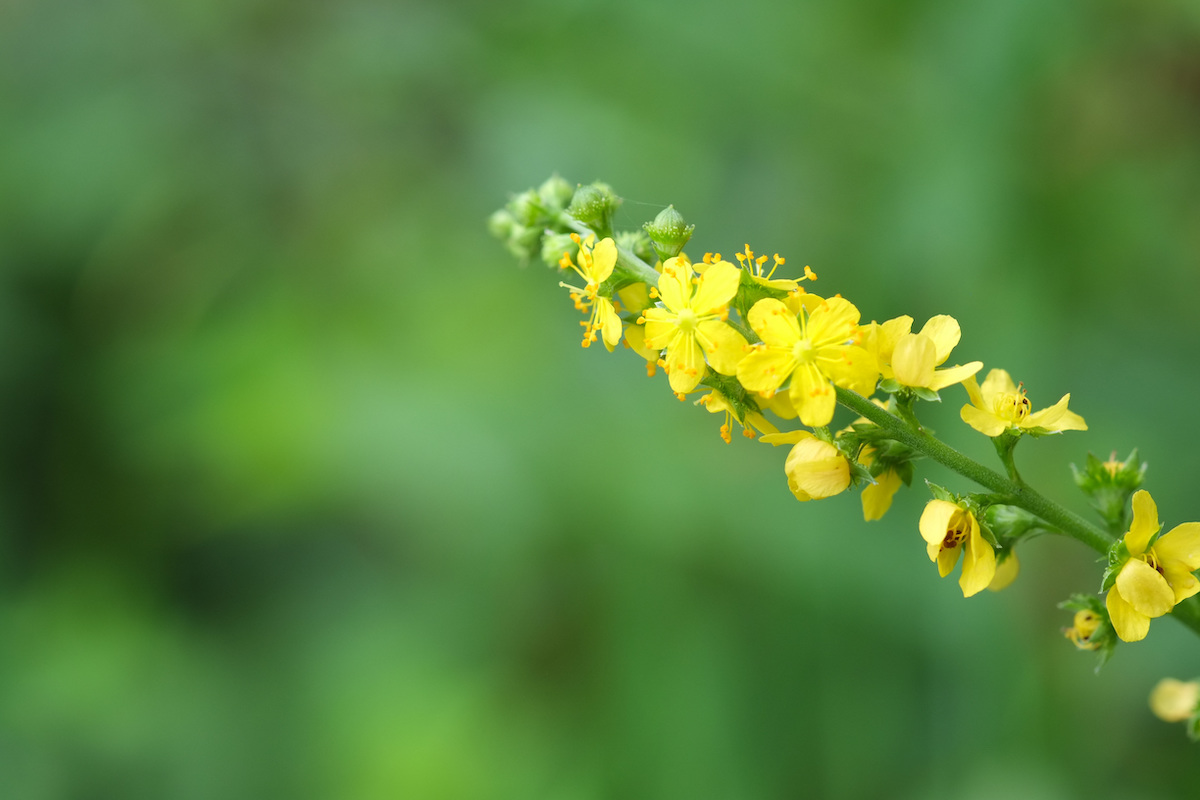
Angelica (Angelica Sp.)
Angelica has a long history as a medicinal plant, dating back to medieval times. It’s a garden perennial that many grow for its pretty ornamental flowers, but if you want to add medicinal flowers to your garden, Angelica has plenty of uses to treat ailments.
This medicinal plant belongs to the parsley family and has large leaves with umbels of white flowers the size of a grapefruit. It truly stands out in your garden, and it has a nice aromatic odor that reminds some people of juniper. There’s no wonder that this plant makes its way into so many flower gardens.
Angelica is best known as candy – historically – because when you cook the hollow stems in sugar, it tastes amazing. It’s an ingredient in some alcohol, and the leaves also serve as a seasoning for meat dishes, soups, and stews.
Angelica Benefits
Evidence shows that Angelica treats a range of problems; it’s best known as a treatment for malaria, anemia, and arthritis. It may serve gynecological purposes like starting a menstrual period. That’s why it’s often recommended to avoid it if you’re pregnant.
Believe it or not, historically, angelica was used as a remedy for the bubonic plague and used as a general tonic for digestive problems, bronchitis, chest colds, and more. Some studies suggest that angelica may have a place in breast cancer treatment! (Studies)
The traditional medicinal uses of Angelica include:
- Treats heartburn and intestinal gas
- Increases Libido
- Treats joint pain
- Improves your appetite
- Limits headaches
- Relaxes your body for sleeping
Growing and Using Angelica
Most people can grow Angelica. It prefers to grow in areas with rich, moist soil with full sunlight. It’s a biennial, so it will produce seeds in the second year, similar to carrots and members of the parsley family.
It’s best to plant this flower annually to have a continuous supply. Since it has an extensive root system, transplanting it isn’t so easy, so once it’s planted, it’s there to stay until it dies.
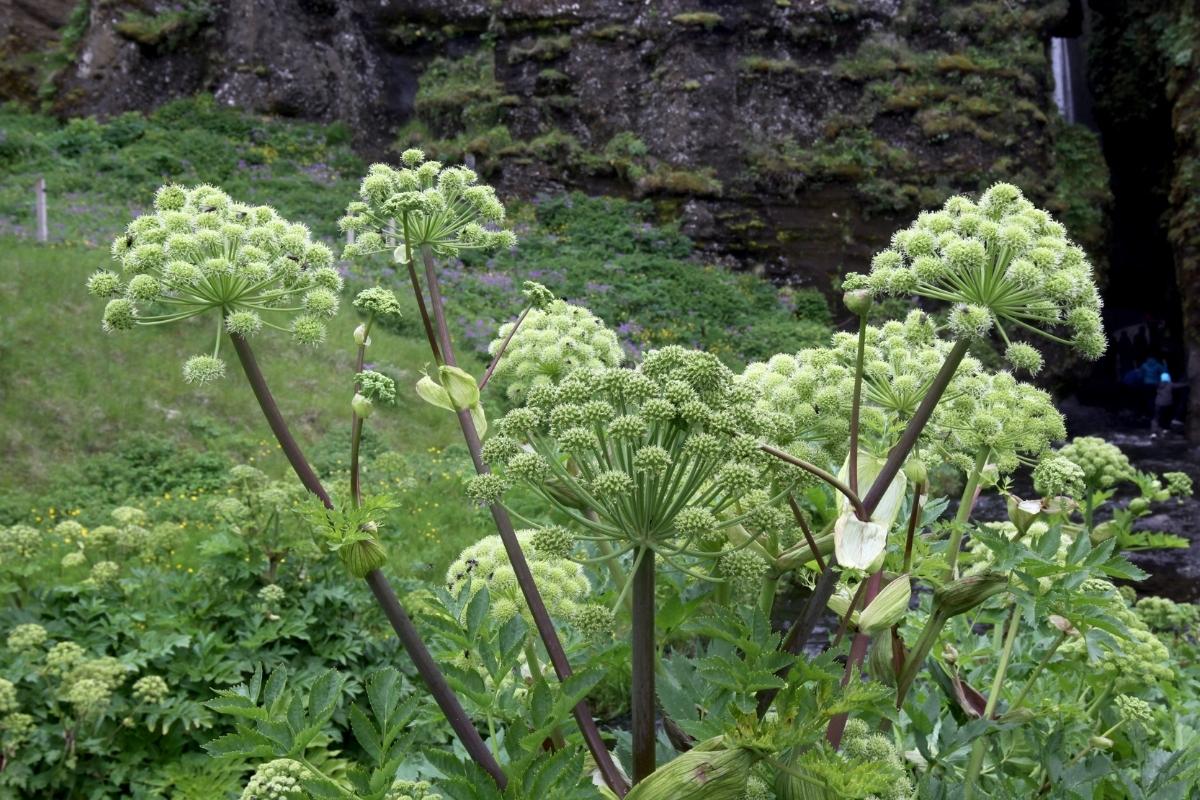
Arnica (Arnica sp.)
Many people are familiar with arnica since most pharmacies sell arnica gels for sore muscles. You might not know that this is a perennial, medicinal flower that grows well in temperate climates, handling frosts like a champ.
It’s easy to confuse the plants with daisies because they bloom throughout the summer with similar flowers. Some like to put them in flower displays, but the flowers are well-known for their medicinal purposes, but make sure you cut them as soon as they bloom to ensure they are picked at the peak time.
Arnica is another herb with a long medicinal history, dating back into the 1500s (or earlier) and it’s still used today. Herbalists created creams, ointments, salves, and liniments from this herb. It must be effective if it’s still as popular today as it was centuries ago!
Arnica Benefits
Arnica is typically used topically, and when done so, it has many benefits. We most often use it to treat bruises, sprains, muscle aches, and joint pains. Evidence shows that arnica may help to treat minor burns as well.
However, remember that the only safe way to use arnica is topically; you should not ingest this medicinal herb. It’s best used as a topical cream or ointment.
The traditional medicinal uses of arnica include:
- Treats sore muscles
- Reduces joint soreness and aches
- Decreases bruising
- Reduces swelling around bug bites
Growing & Using Arnica
Arnica grows well in USDA zones 4 to 9, and some varieties grow in zone 3. The plant requires full or partial sun; make sure you check the specific variety you grow to know the sun preferences.
Arnica is known as an easy plant to grow because it’s not picky about where it grows. That’s why you may find it growing wild in some areas. The only thing it dislikes is waterlogged, soggy ground, so make sure you pick a well-draining area.
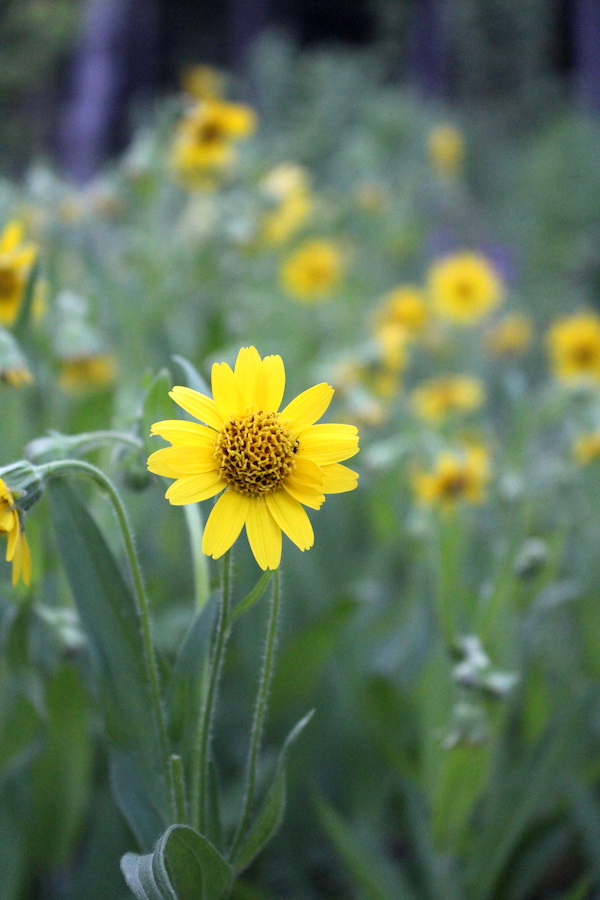
Bee Balm (Monarda sp.)
Bee balm is a beautiful flowering plant that belongs to the mint family with flowers ranging from bright red to white. Many varieties are perennials, typically reaching three feet tall. When growing this plant, remember that it is as invasive as other members of the mint family.
Bee balm has a long history of being a medicinal flowering plant. All parts of the plant have medicinal properties, and the flowers make delicious herbal teas.
We know that this herb has antimicrobial and soothing properties, so it’s often used as a cold and flu treatment. The soothing effect treats many digestive problems like indigestion and bloating.
Bee Balm Benefits
You can find many different traditional uses for bee balm since it has been used for centuries as both a kitchen herb and in herbal medicine. It’s best known for its medicinal properties, such as antibacterial, antiviral, and antimicrobial properties.
The traditional medicinal uses of Bee Balm include:
- Treats bug bites
- Reduces anxiety
- Gets rid of gas and nausea
- Treats sore throats
Growing & Using Bee Balm
Bee balm is one of the easiest plants to put in your garden. It prefers a sunny location but tolerates some shade, especially in areas with hot summers. The plants grow well as long as the soil stays moist, and they need a good general fertilizer. Make sure you deadhead the plants to keep them growing and creating new blooms.
- How to Grow and Care for Bee Balm
- 12 Ways to Use Bee Balm
- How to Make a Bee Balm Oxymel
- Bee Balm Tincture
- Bee Balm Mouthwash
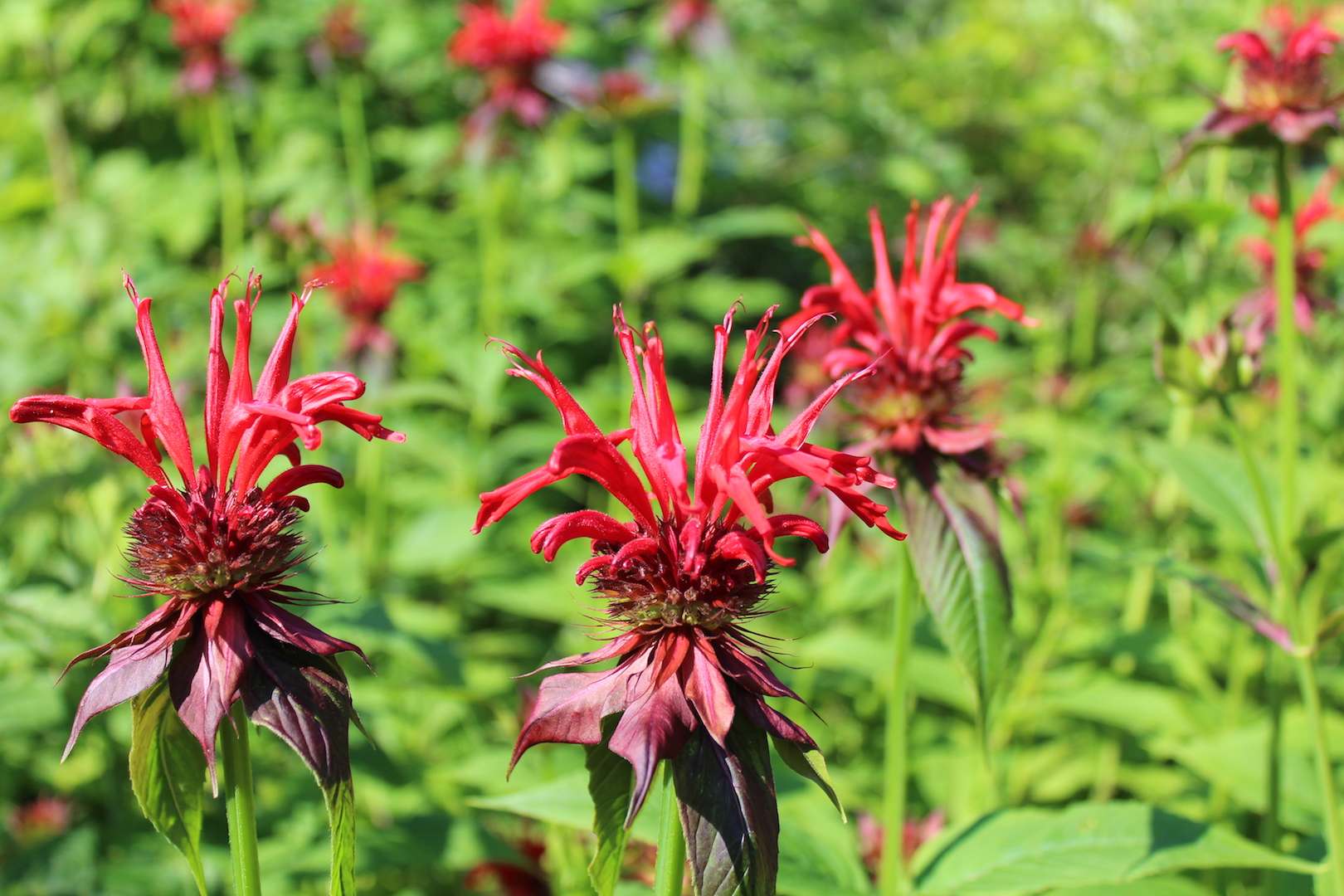
Black-Eyed Susan (Rudbeckia hirta)
Most people easily recognize a black-eyed Susan flower; it’s a common perennial wildflower found abundantly throughout North America. These plants often reach up to three or four feet tall with dark brown centers and yellow, daisy-like petals. You see them blooming along roadsides starting in June and lasting all summer.
However, chances are you had no idea that this flower is related to echinacea and has many of the same properties. Historically, Native Americans used its flowers to treat ailments like earaches and snakebites. Always avoid the seeds; these are not safe for consumption!
Black-Eyed Susan Benefits
You’ll find plenty of benefits for black-eyed Susan flowers. Some studies show that this medicinal flower stimulates your immune system like echinacea, perhaps even better! So, it’s possible to add this flower to your cold-fighting arsenal. (Study)
This may be due to the roots having immune-stimulating properties. Some studies indicate that the immune boosting properties may be better than echinacea, and this plant also has antibacterial effects against tuberculosis! (Effects)
The traditional medicinal uses of Black-Eyed Susan include:
- Getting rid of parasitic worms
- Treating earaches
- Treating minor cuts and scrapes
- Reducing inflammation around minor wounds.
Growing & Using Black-Eyed Susan
Growing black-eyed susan flowers in your garden is easier than you may imagine. These flowers require little to no work since they are wildflowers, and they generally need little to no help from humans.
The best thing you should do is to find a spot in your garden that receives sunlight; the plants need six to eight hours of sun every day.
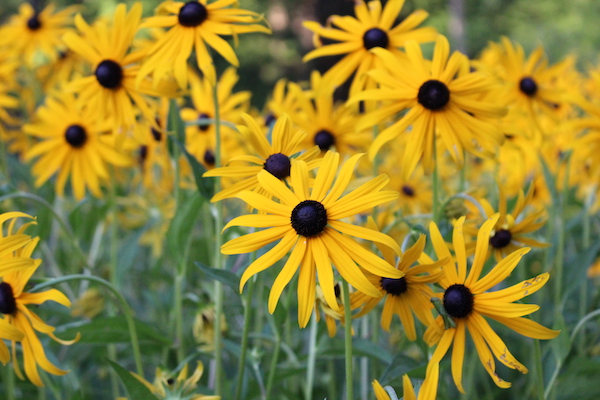
Blue Vervain (Verbena hastata)
Another common North America wildflower with medicinal properties is blue vervain. This flower grows alongside streams and open areas; you’ll notice the blue-purple blooms that appear from July to October.
Since blue vervain is a native plant, we know indigenous people used this herb for health benefits, and a lot of folklore surrounds this plant. It has many nicknames, like “Herb of the Cross” because it’s believed that this herb stopped Jesus’ wounds from bleeding, and we know Hippocrates and the ancient Egyptians used this herb.
What a rich history!
We know that this herb has many potential uses such as treating anxiety, depression, and insomnia problems. It’s possible to use blue vervain internally and externally, but consuming too much could interfere with blood pressure medication or hormone therapy. Consulting your doctor if you’re on these medications is essential. (Study)
Blue Vervain Benefits
Several studies focus on the benefits of blue vervain as a medicinal flower. Aside from treating anxiety and helping with sleeping problems, evidence shows that it has pain-relieving properties and reduces inflammation. It’s suggested that it will also treat stomach ulcers.
Another traditional benefit is that blue vervain helps nursing mothers by stimulating breast milk production. This is considered an herbal galactagogue that has helped mothers for hundreds of years. (Benefit)
The traditional medicinal uses of blue vervain include:
- Treats depression
- Stops cramps and headaches
- Gets rid of coughs
- Treats minor cuts and scrapes
Growing & Using Blue Vervain
Blue vervain is a beautiful flower that grows up to three feet tall, blooming from mid-summer to early fall. Gardeners can sow the seeds directly in late summer or early fall, but they also have to be cold stratified, so you can keep the seeds in the refrigerator for up to two months.
This plant grows best in full sunlight or partial shade. Make sure the soil is full of nutrients, but make sure it’s well-draining since soggy roots will kill this plant.
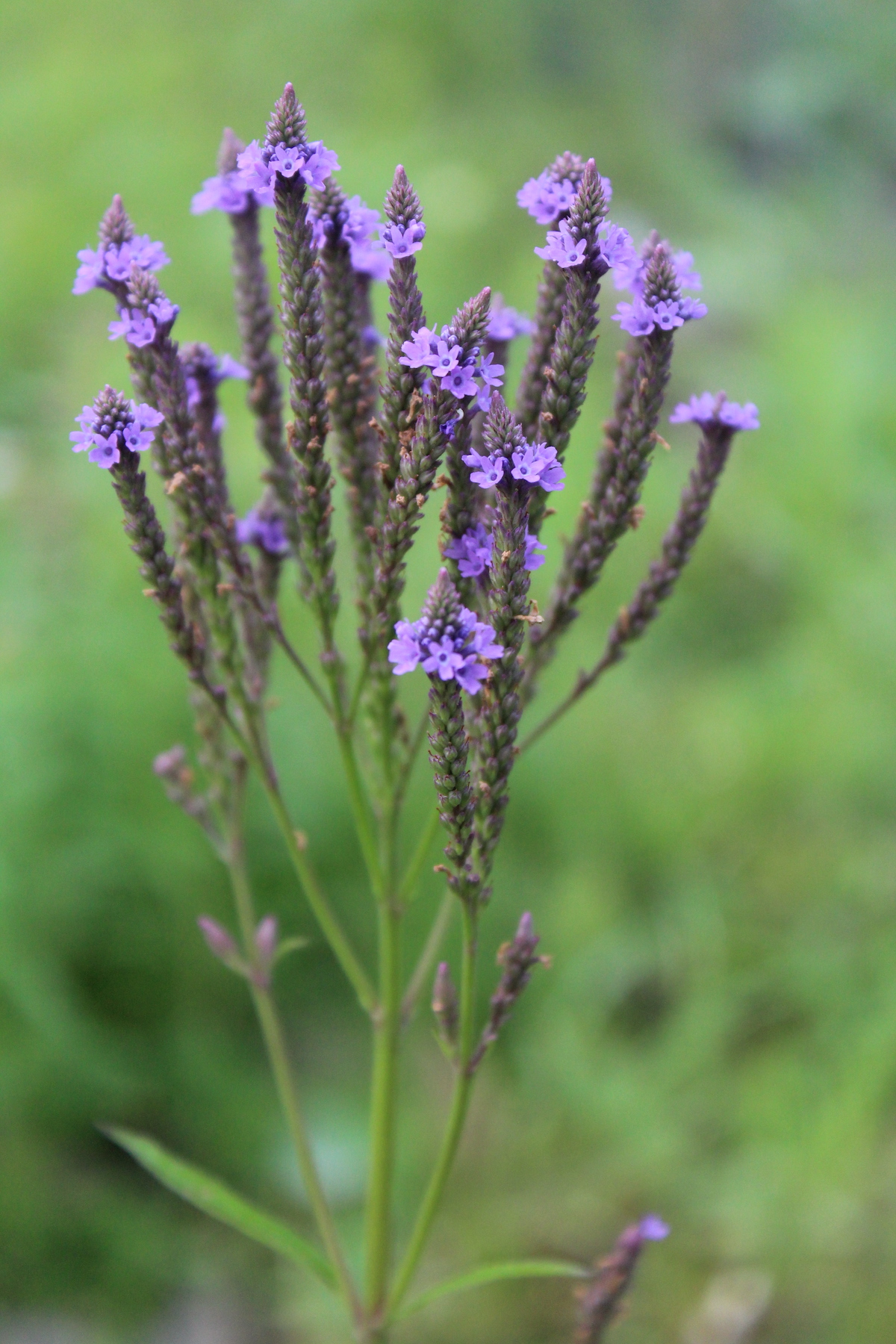
Borage (Borago officinalis)
Borage plants produce cheerful, bright blue flowers that attract pollinators to your garden. That’s why borage is often listed as a great flower for companion planting and pollinator gardens.
It’s an herb native to the Middle East. Most assume that it is an annual, but this two feet tall plant drops seeds, so most gardeners find that it comes back on its own in the following years.
Borage belongs on the list of some of the most popular herbal flowers. Some studies show that borage treats various diseases, such as arthritis and menstrual-related problems.
Borage Benefits
All parts of the borage plant have medicinal properties, but the flowers are some of the most common parts used. It treats skin disorders, such as eczema, and deals with premenstrual disorder symptoms. Some suggest that it helps with inflammation and swelling in various parts of your body.
Here are some traditional benefits of using borage as a medicinal flower:
- Gets rid of chest congestion and coughing
- Relieves fevers
- Treats anxiety and depression
- Increases breast milk production
Growing & Using Borage
Borage requires soil that is full of organic matter and well-draining. The seeds should be sown directly into your garden after the danger of frost passes. Make sure you plant it near your vegetable garden since it will attract plenty of pollinators.
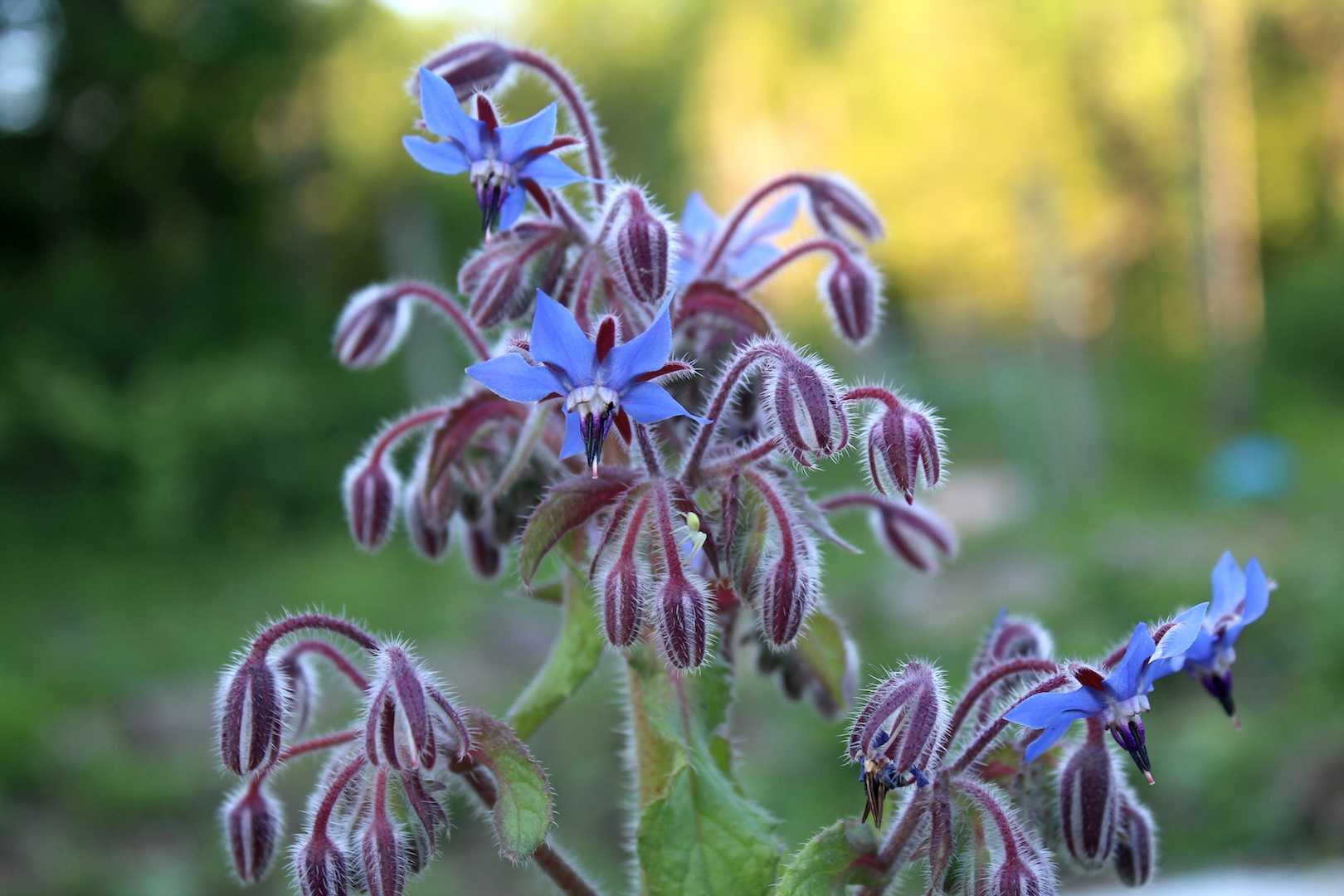
Calendula (Calendula officinalis)
Calendula is known as a powerful medicinal flower, and it’s always on the list for new herbalists to use. It’s a perennial plant if you live in a warm climate, but if you live in a more temperate climate as I do, it is an annual plant instead. The plant needs full sunlight with fertile, well-draining soil.
Calendula is a cheerful, yellow, or orange flower that looks so pretty in the garden. It also serves well as a companion plant in the vegetable garden.
All sorts of studies look at calendula and the ways to use it. Most think of calendula as a flower only good for skin problems because it’s frequently used in skin products. However, studies show that this plant has antiviral properties as well!
Calendula Benefits
Calendula treats all sorts of issues. The most common ailments that herbalists use calendula for is skin problems like minor wounds, dry skin, rashes, and more. However, studies show that this herb also reduces inflammation, controls bleeding, and relieves toothaches. (Studies)
It’s used internally as an immune-boosting herb as well.
The traditional medicinal uses of Calendula include:
- Treats heartburn
- Heals eczema and skin rashes
- Treats burns
- Recommended for swollen lymph nodes
- Takes care of stings and bug bites
Growing & Using Calendula
Even those with a black thumb can grow calendula in their garden. You can start the seeds indoors six weeks before the last frost date in your area or directly sow the seeds inside your garden.
Make sure you pick a sunny area; calendula appreciates as much sun as possible. Make sure you cut the flowers regularly; the more you cut, the more growth you’ll receive.
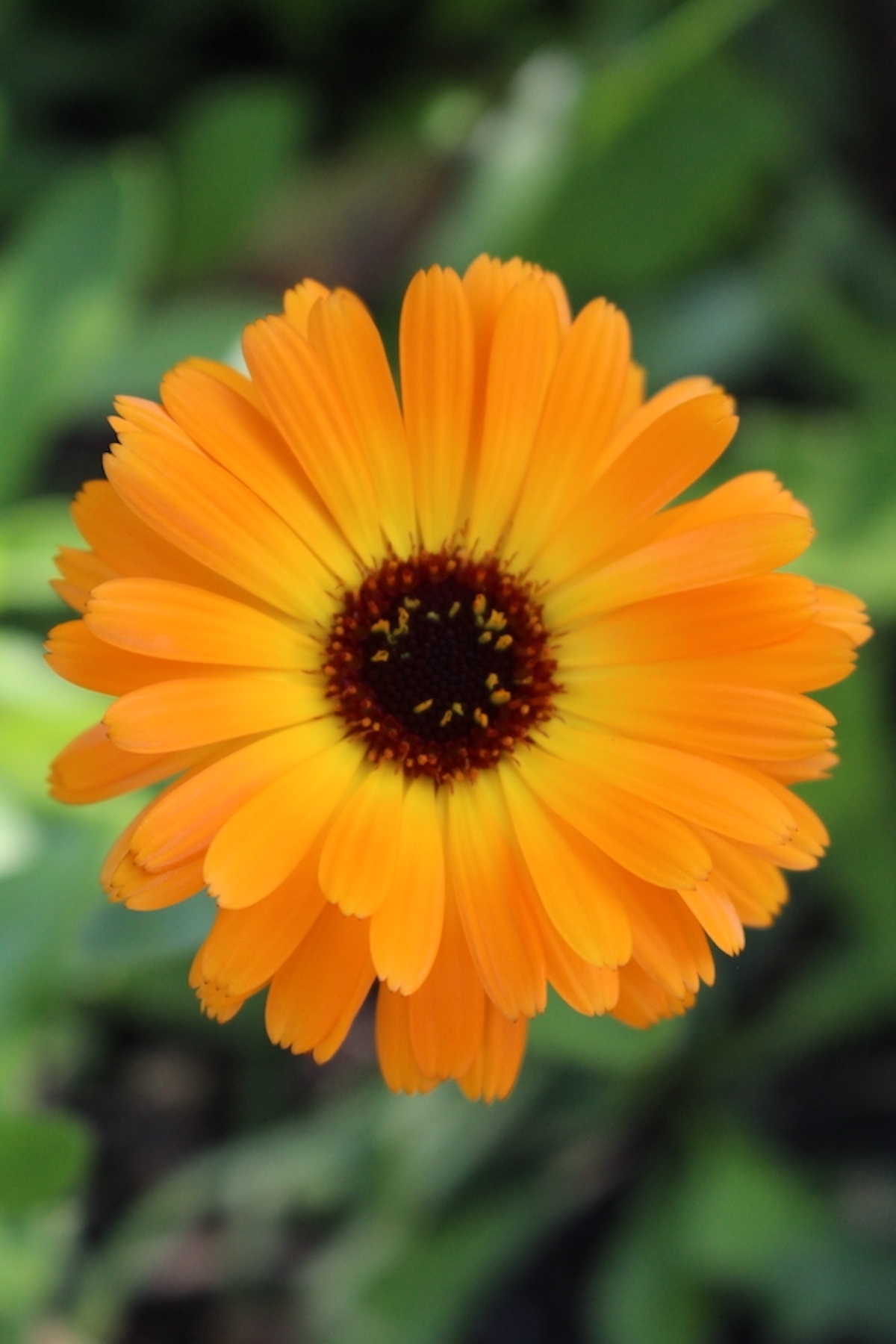
California Poppy (Eschscholzia californica)
Who doesn’t love California poppies? These are little flowers that add bursts of color into your garden, and they often pop up along roads and streams in the spring. Those who live in cooler regions have the blooms for longer than those in hot climates.
California poppy is an annual or a perennial, depending on where you live, with a history as a medicinal plant that contains sedative properties. However, it’s important to know when using an herbal flower that only the above ground parts of the plant are safe to use, including the petals. You should always know what parts of the plant are safe for medicinal purposes.
California Poppy Benefits
We know that, historically, California poppies were used as a sedative because they contain natural compounds that have sedative and analgesic effects. However, that doesn’t mean evidence shows it helps with anxiety or depression; experts are up in the air about that!
Herbalists agree that this flower is great for treating mood problems, insomnia, and promoting relaxation. You may also use it to reduce general aches in your body. (Studies)
The traditional medicinal uses of California Poppy include:
- Helps you get a restful sleep
- Encourages relaxation
- Treats nerve pain
- Treats toothaches and teething pain in children
- Takes away menstrual cramps
Growing & Using California Poppy
California poppies are a perennial if you live in a warm climate, and the plants self-seed easily once planted. It’s easiest to directly plant the seed outdoors in rich soil, full of compost. These plants require full sunlight and require little care and no fertilization.
The flowers bloom in the early summer until the early fall. Make sure you cut the flowers as soon as they bloom!
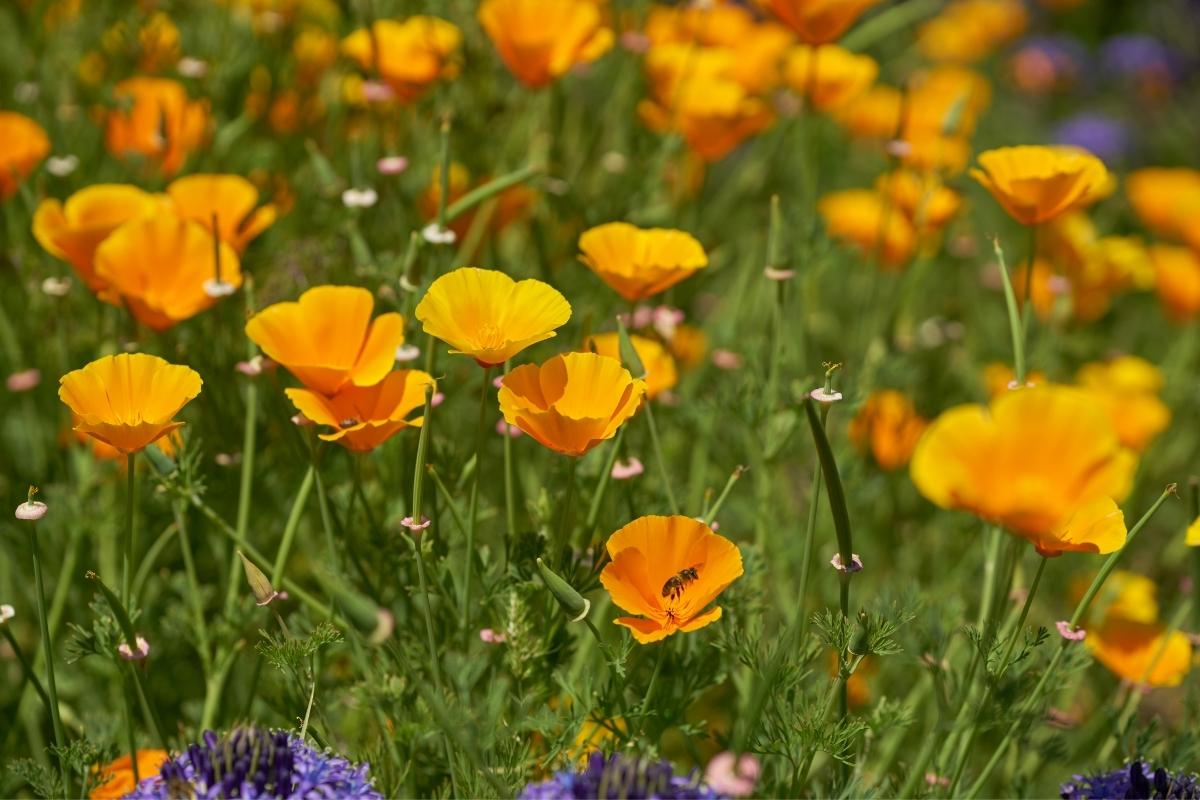
Clover, Red (Trifolium pratense)
Red clover is different from white clover, so it’s important to note that before you dive into using this medicinal flower. It’s often grown in gardens and farms as a cover crop or forage for grazing. Livestock loves this plant because it has a high sugar content, and it’s easy to grow for consumption.
Before red clover became a popular cover crop, it treated dozens of ailments. We know that Chinese herbalists brewed red clover tea to help with bronchial health problems. The most popular way to use this herb is still as a tea, but there are other options as well.
Red Clover Benefits
Since we know red clover has been used for centuries as a medicinal flower, it’s sure to have plenty of benefits. This plant helps with various ailments like menopause symptoms and osteoporosis.
The traditional medicinal uses of red clover include:
- Decreases osteoporosis risk
- Reduces hot flashes and night sweats
- Treats anxiety and depression
- Decreases vaginal dryness
Growing & Using Red Clover
This plant is relatively easy to grow. All you have to do is sow the seeds wherever you want the flowers to grow in either part shade or full sunlight and wait 60 to 80 days to grow.
- Foraging and Using Red Clover
- DIY Red Clover Flour
- How to Grow Red Clover
- Red Clover Tea
- Red Clover Tincture
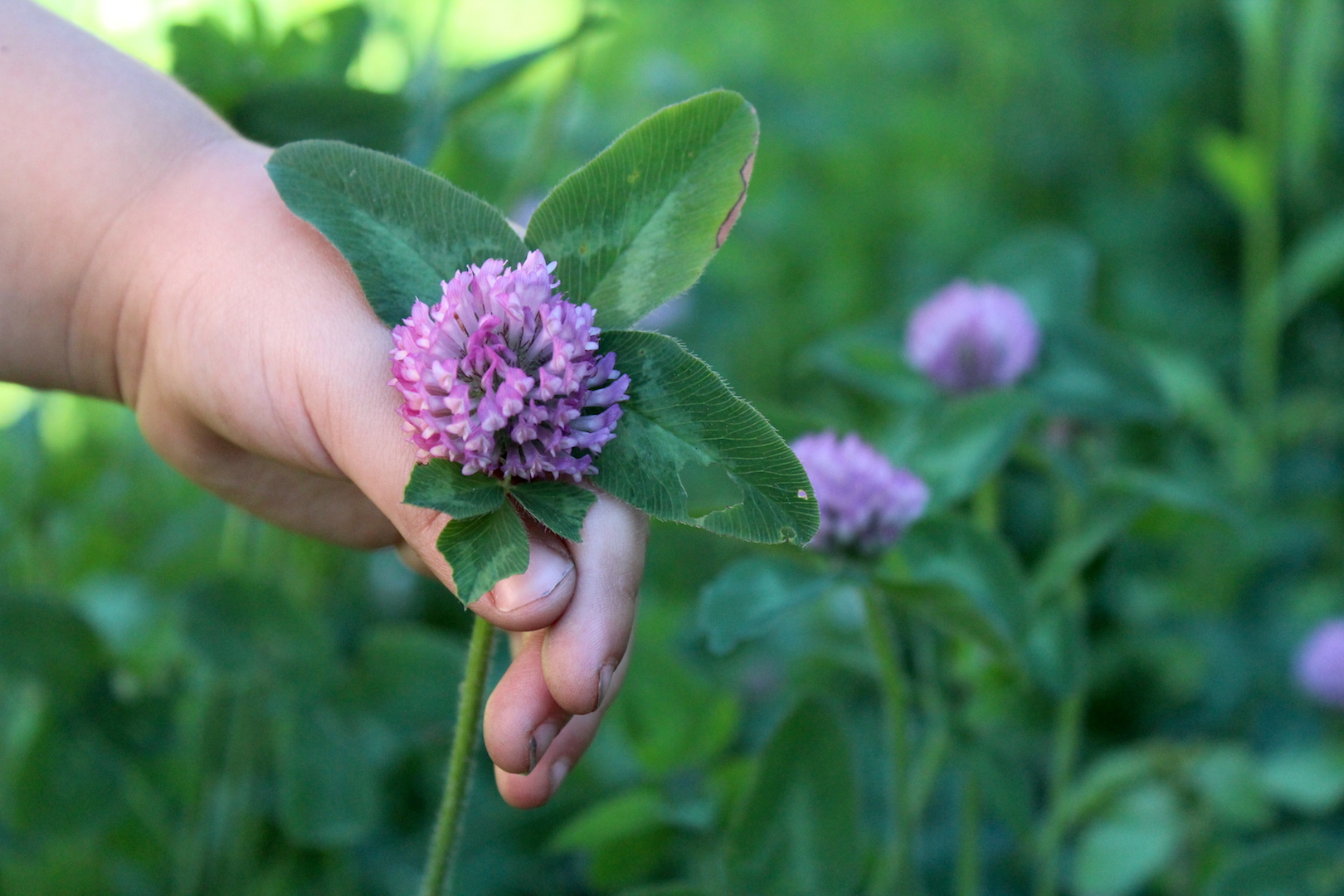
Chamomile (Matricaria recutita & Anthemis nobilis)
Chamomile is right up there with lavender when it comes to popular herbal medicines. Everyone knows that chamomile helps your body relax, and people drink chamomile tea to help them sleep, even if they aren’t interested in other herbal remedies.
Chamomile comes in two varieties: Roman chamomile & German chamomile. If you opt to grow this medicinal flower at home, the variety with the most herbal uses is Roman chamomile. The most striking difference is how they grow since Roman chamomile creeps along the ground like a ground cover while German chamomile grows upright, reaching up to two feet tall.
This herbal flower is well-studied and considered a must-have staple in nearly all herbal apothecaries. I use it in many of my tinctures and teas because it has so many uses. If you want to grow a medicinal herb garden, I would include this one.
Chamomile Benefits
Chamomile is a well-studied plant, and we know it helps to improve cardiovascular health, stimulates your immune system, and relieves stress. The parts of the plant with the most medicinal properties are the flowers; they’re known for calming your body, nervous system, and digestive system. (Study)
No wonder people love to drink chamomile tea!
The traditional medicinal uses of chamomile include:
- Reduces inflammation
- Helps with coughs and chest congestion
- Calms tummy aches
- Helps with teething pain
- Soothes irritated skin
Growing & Using Chamomile
If you’re dreaming of homemade chamomile tea, then you need to try growing chamomile at home. Plant the seeds in your garden after the last spring frost, well spacing the plants because they grow wide. These plants need full sunlight, but some afternoon shade is okay.
Make sure you mix compost into the soil and water the plants regularly. Harvest flowers after blooming, when the petals start to bend backwards.
- Chamomile Plant Growing
- Homemade Chamomile Tincture
- Homemade Chamomile Salve
- How to Make Chamomile Tea

Comfrey (Symphytum officinale)
Comfrey is a tall, spring-flowering plant with pretty purple, pink, and yellow flowers. It grows well in many areas, and many say that it’s invasive. It’s spread all over the place in our garden. It’s a perennial plant that comes back year after year, so you only have to plant it one time.
We know historically comfrey treated pain, inflammation, and swelling in the muscles and joints. Traditionally, herbalists used the roots and leaves before discovering that the flowers have properties as well.
However, modern experts recommend that you avoid taking comfrey internally because it may contain some toxic compounds. It depends on the strain, which is hard for the average gardener to know.
Comfrey Benefits
As long as you avoid internal consumption, comfrey treats inflammatory conditions, like arthritis and muscle sprains. If you have any swelling or inflammation around your muscles and joints, comfrey is the herbal flower for you. (Study)
The traditional medicinal uses of comfrey include:
- Treats skin wounds
- Helps heal minor sprains and strains
- Deals with back pain
- Historically used to treat stomach issues like diarrhea but avoid internal use.
Growing & Using Comfrey
Comfrey is an easy-to-grow herbaceous perennial best planted in full sunlight or partial shade. It requires well-draining, rich soil to grow, but it thrives well in other conditions as well. Oftentimes, gardeners say it grows in places you don’t want to have it.
- Growing Comfrey in a Permaculture Garden
- Comfrey Oil
- Comfrey Salve
- Comfrey Tincture & Cream for Joints & Muscles

Cornflower (Centaurea cyanus)
You might know cornflowers as “bachelor’s buttons;” that’s how I knew these flowers for years until I recently learned they had another name. These pretty blue flowers are annual plants that typically self-seed year after year, so you only need to plant them once. Since they reach two to three feet tall, they make excellent cut flowers.
Unlike other medicinal flowers on our list, the only part of this plant you may use for herbal remedies is the blue-colored flowers. It’s not recommended to use other parts of this plant.
Cornflower Benefits
While experts don’t prove the historical uses for cornflowers, some studies show that you may use this herbal flower for treating fevers, constipation, coughing, and chest congestion.
We also know that the flowers contain different vitamins like potassium and calcium, along with flavonoids and mineral salts. All of these work to reduce inflammation in your body and have diuretic properties. One of the strongest compounds in cornflowers is anthocyanin, a flavonoid with antioxidant and anti-inflammatory properties. (Studies)
The traditional medicinal uses of cornflower include:
- Reduces fevers
- Relieves constipation
- Reduces water retention
- Eases menstrual cramping
- Helps you feel less anxious and stressed.
Growing & Using Cornflower
The best time to plant these seeds is in the early spring; they tolerate freezing temperatures. They prefer full sunlight and well-draining, moist soil. The plants tolerate drought conditions well once established, so you don’t have to stress about making sure you water regularly.
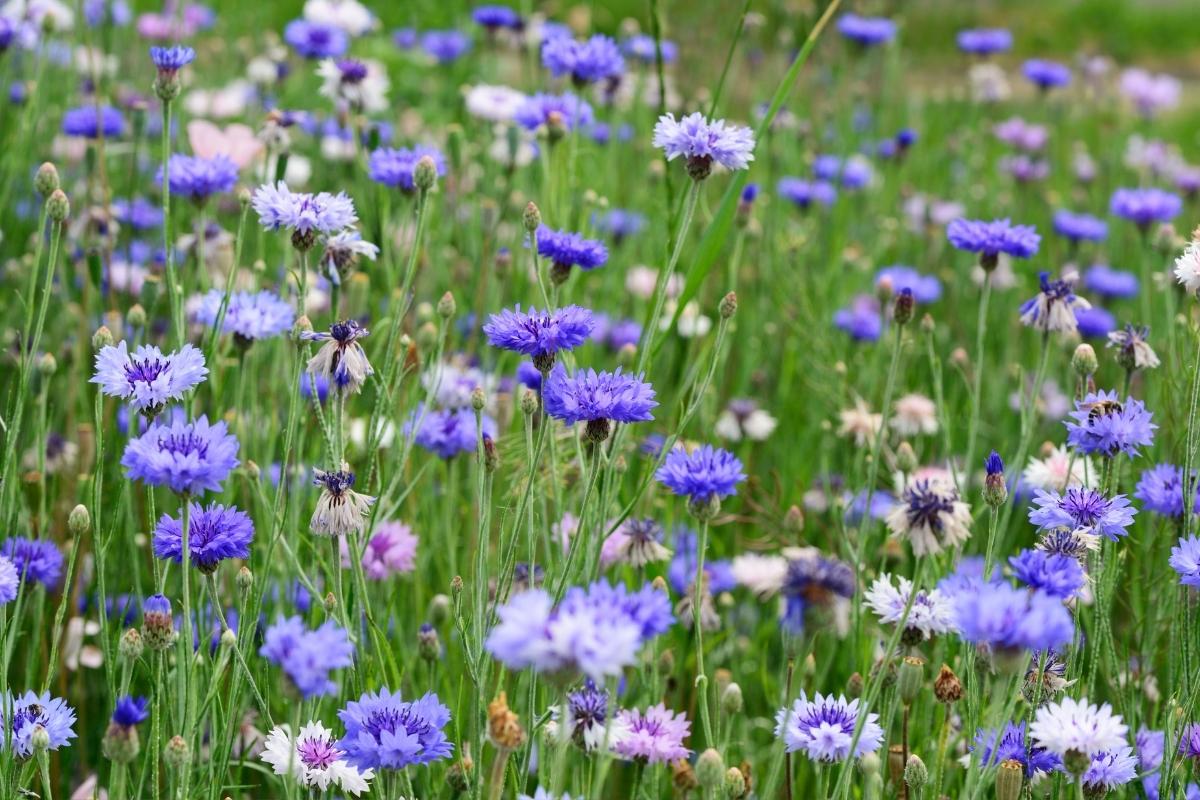
Daisy (Bellis perennis)
Daisies are cheerful, happy flowers that are easy to grow no matter where you live. They’re perfect for new gardeners since they thrive in a variety of conditions. Many have no idea that daisies are actually hardy and drought-tolerant plants!
Few studies exist about the medicinal uses of daisies, but some indicate that they may have biphasic effects that reduce anxiety and stress. Herbalists know daisies treat bruising, and some evidence suggests that it even helps with injuries during childbirth. (Studies)
Daisy Benefits
Besides reducing anxiety and stress, daisies are known for having anti-inflammatory properties. If you have a strain or injury, this flower may help with the swelling afterwards and speed up your healing.
Some studies focus on daisies treating wounds, verifying that it works well. Traditionally, it is used in infusions and tinctures to relieve coughs and colds. (Studies)
The traditional medicinal uses of daisy include:
- Treats coughing and chest congestion
- Reduces inflammation
- Relieves minor aches and pains
Growing & Using Daisy
If you decide to grow daisies in your home garden, plant them in rich, well-draining soil that receives full sunlight. They grow best without shade, but make sure you pick an area that gives your plants from strong winds because these tall plants may flop over.

Dandelion (Taraxacum officinale)
In recent years, the truth about dandelions began to unravel, and more people realize that those little yellow flowers that dot your yard in the spring are more than weeds. Dandelions are powerhouse medicinal flowers that grow totally free, and they aren’t picky about where they grow.
Dandelions quite literally pop up anywhere they want like the cracks in the sidewalks.
We know dandelions have antiviral and antimicrobial properties, so they are great for fighting off bacteria and infections. Studies show that dandelions have an antiviral effect against hepatitis B! (Studies)
Dandelion Benefits
Experts are still learning about all of the dandelion’s medicinal benefits, but what we do know is quite impressive. Dandelions help with digestive problems, preventing gas and heartburn. It’s a cleansing herb that supports healthy organ function, and historically, Native Americans used dandelions to build up energy and endurance.
The traditional medicinal uses of dandelions include:
- Treat UTIs
- Increase the production of urine
- Relieves constipation
- Stops bothersome gas
- Treats ulcers
Growing & Using Dandelion
Since dandelions grow nearly anywhere – even sidewalk cracks – you can bet growing dandelions purposefully is easy. In general, the plants prefer full sunlight and well-draining soil with neutral to acidic pH range. The good thing is these plants grow nearly anywhere in USDA zones 3 to 9.
- How to Grow Dandelions
- Dandelion Tincture
- Making Dandelion Oil
- Dandelion Salve Recipe for Sore Muscles
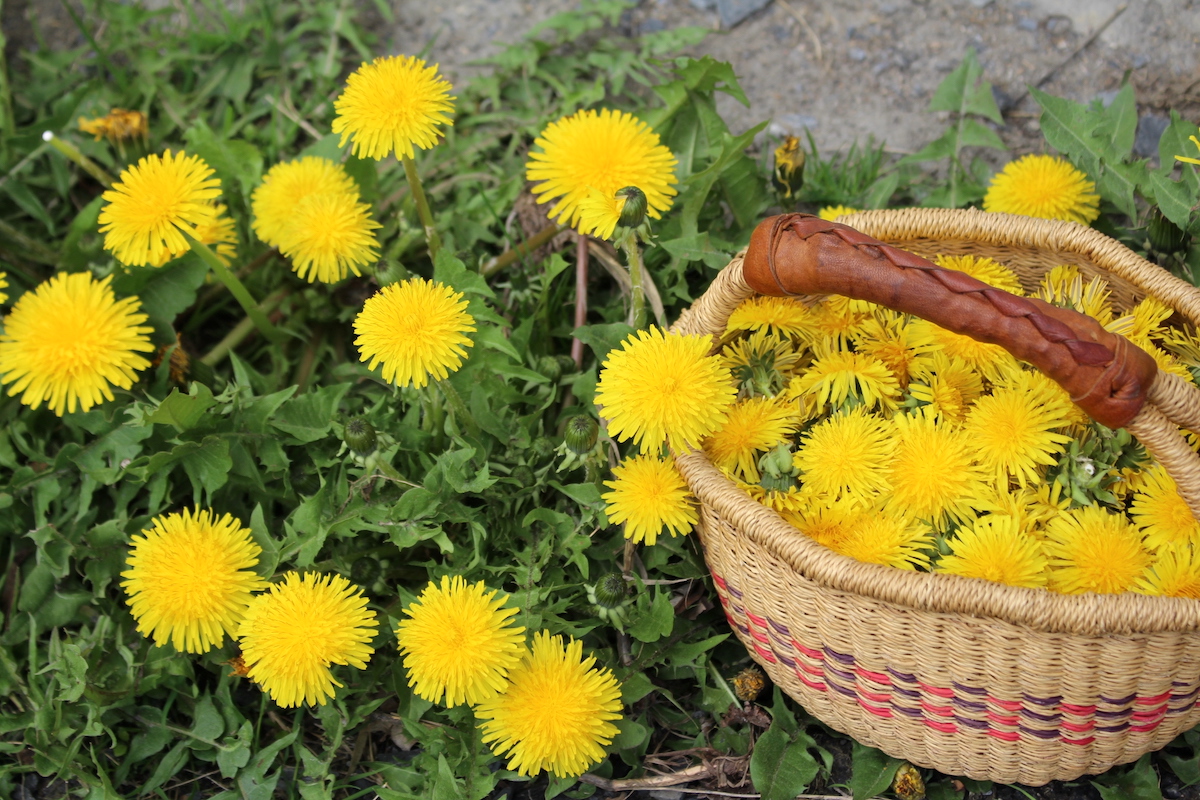
Echinacea (Echinacea purpurea)
Echinacea is another powerhouse medicinal herb you need to have in your apothecary. Most call these flowers coneflowers, a common garden perennial in North America. It’s a native plant that attracts pollinators, so you find these perennials growing all over the place.
Echinacea is one of the most popular herbs for new herbalists because it has so many uses and properties. It’s highly recommended for treating the common cold, and while science has yet to back up these claims, a lot of people swear by taking echinacea when they feel under the weather.
Including me! Our family swears by echinacea during cold and flu season.
Echinacea Benefits
Echinacea has many benefits; it contains antiviral properties that work against avian influenza strains. Some studies show that this herb also fights off rhinovirus and other respiratory viruses while also having anti-inflammatory properties. (Studies)
The traditional medicinal uses of Echinacea include:
- Reduces inflammation
- Treat the common cold and reduces the severity
- Boosts your immune system
- Eases cold symptoms like runny noses and sneezing.
Growing & Using Echinacea
Echinacea thrives when grown in full sunlight but tolerates partial sunlight. Some morning shade or afternoon shade will be fine as long as the plant gets a minimum of six hours of sun. They tolerate poor soil but not wet, waterlogged soil, so make sure you consider if the area is well-draining.
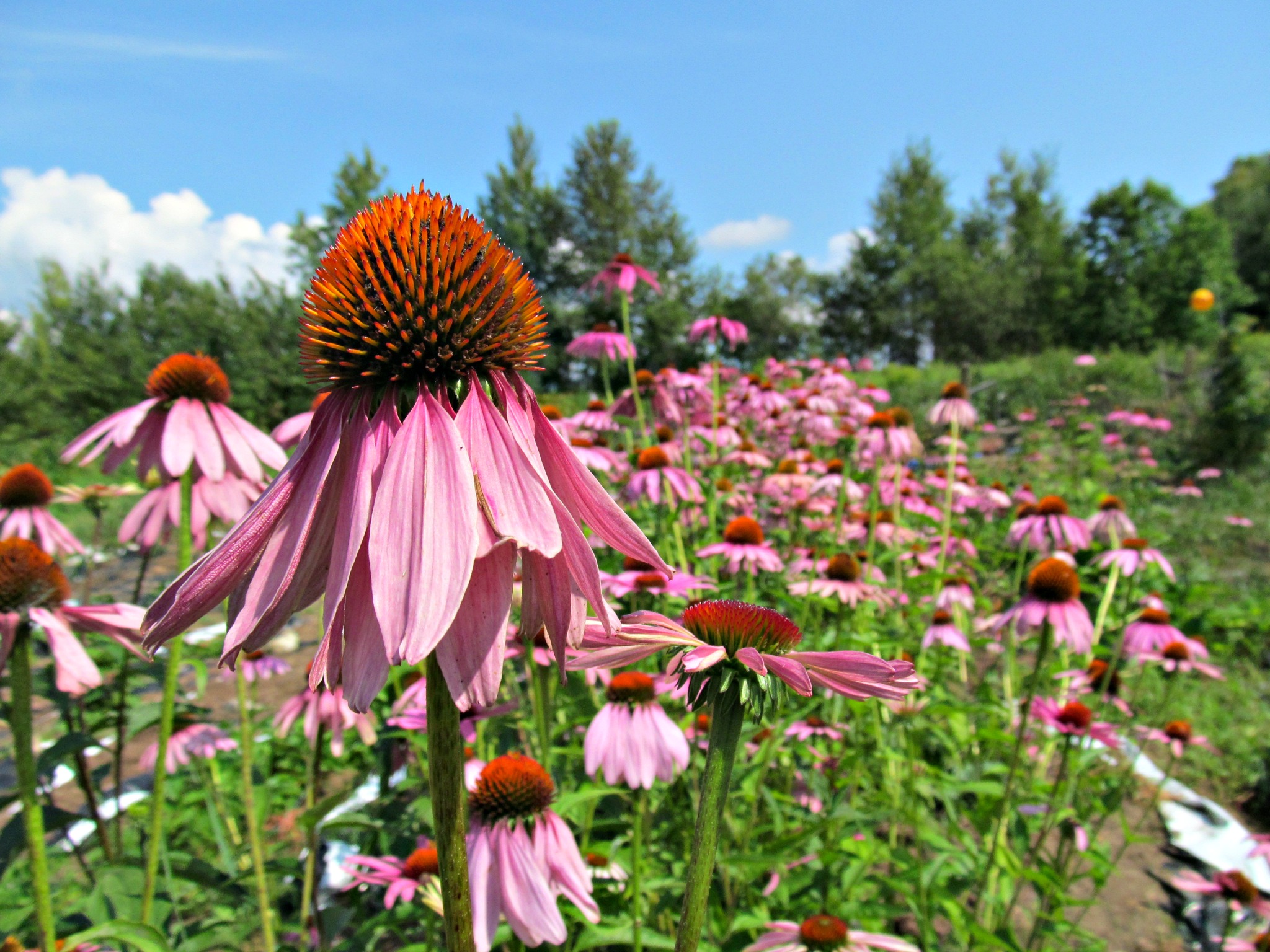
Elderberry Flowers (Sambucus nigra)
Most focus on the elderberries that grow on the large elderberry bush, native to North America. These berries are great for fighting colds and viruses, and evidence shows they help to reduce a cold and its severity. (Evidence)
However, there is more to an elderberry bush than the berries – the flowers have medicinal purposes as well! The bushes produce little white or yellow clusters of flowers that emit a sweet fragrance. Elderflowers have a long history of medicinal uses as well, so these plants are more versatile and useful than you may think!
Elderberry Flowers Benefits
Elderflowers have been used for thousands of years, and they help boost your immune system and fight off infections. Drinking elderflower tea may help give you relief when suffering from a cold. The blooms may treat conjunctivitis and relieve red, itchy eyes or reduce toothache pain.
The traditional medicinal uses of elderflower includes:
- Combats sore throats and toothaches
- Reduce inflammation and pain from sprains
- Gives relief for itchy eyes
- Fights colds and flus
Growing & Using Elderberry
Elderberry bushes are great to add to your garden or backyard, and elderflowers come from the bushes. The shrubs grow best in full sunlight or partial shade, and they grow in nearly any type of soil like clay soil and sandy soil! However, make sure you remember to prune, a necessary step for healthy elderberry bushes.
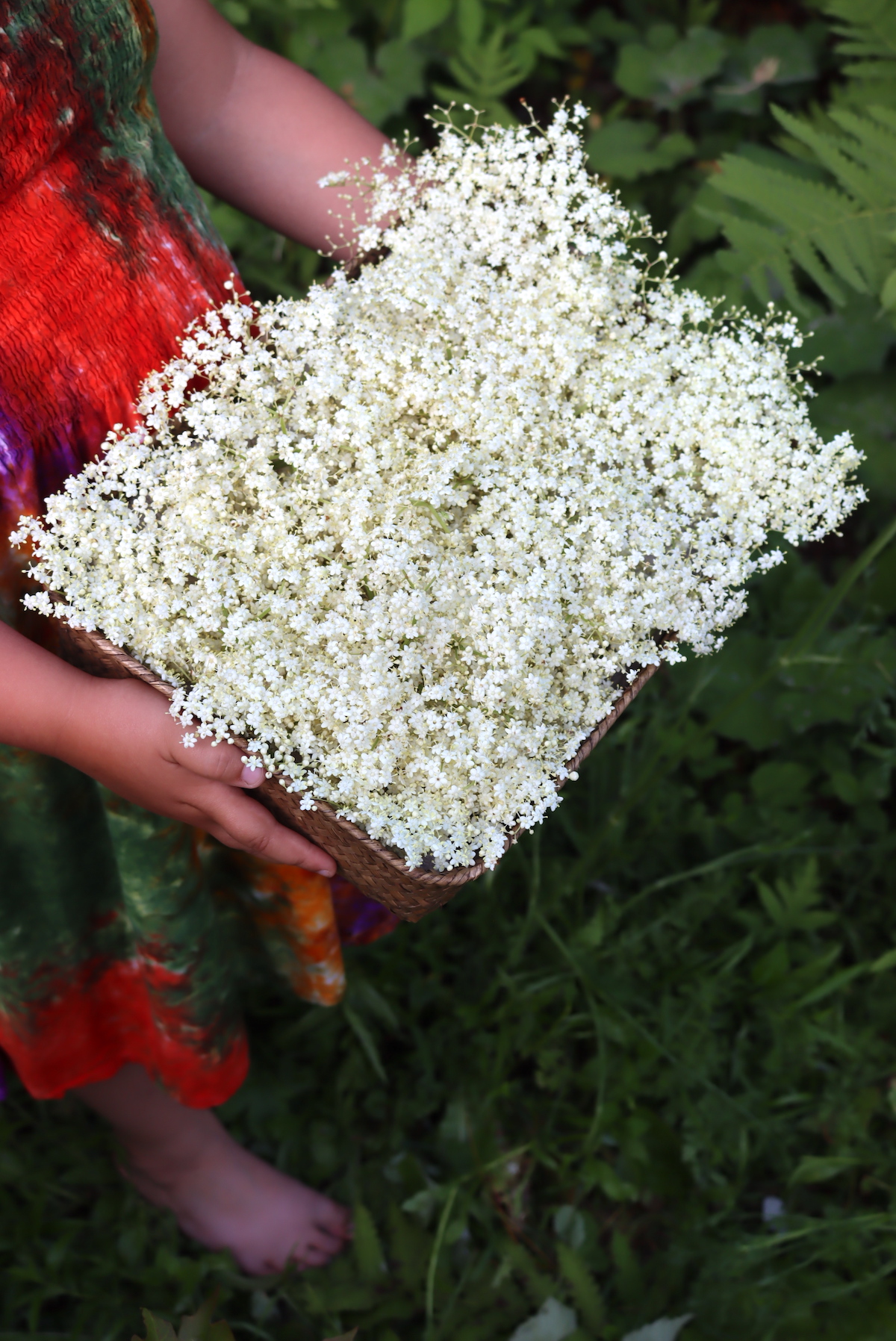
Evening Primrose (Oenothera biennis)
Another native North American plant is evening primrose; it is an annual, biennial, or perennial depending on the variety of the plant. These plants often reach up to six feet tall and 24 inches wide with a central flowering stalk. Their name is due to the flowers showing up late in the day on the first day then opening by mid-morning the following day.
Evening primrose is most often associated with women’s health because it may be used to help reduce premenstrual symptoms. Some women take evening primrose oil capsules to help their cervix ripen before labor, but it often has to be taken for several weeks or months to see the benefits. (Studies)
Evening Primrose Benefits
Many of the benefits of evening primrose surround women’s health, but there is more to this plant than that. We know traditional uses included treating sore throats, healing bruises, and kicking digestive problems.
The traditional medicinal uses of evening primrose include:
- Reduces dry skin and skin inflammation
- Treats eczema
- Reduces inflamed skin conditions
- Relieves PMS symptoms, such as bloating and irritability
Growing & Using Evening Primrose
Evening primrose is an herbaceous plant that often reaches up to 5 feet tall. The plants require full or partial sunlight and moist, well-draining soil. If you live in USDA zones 4 to 9, you’ll be able to grow these plants!
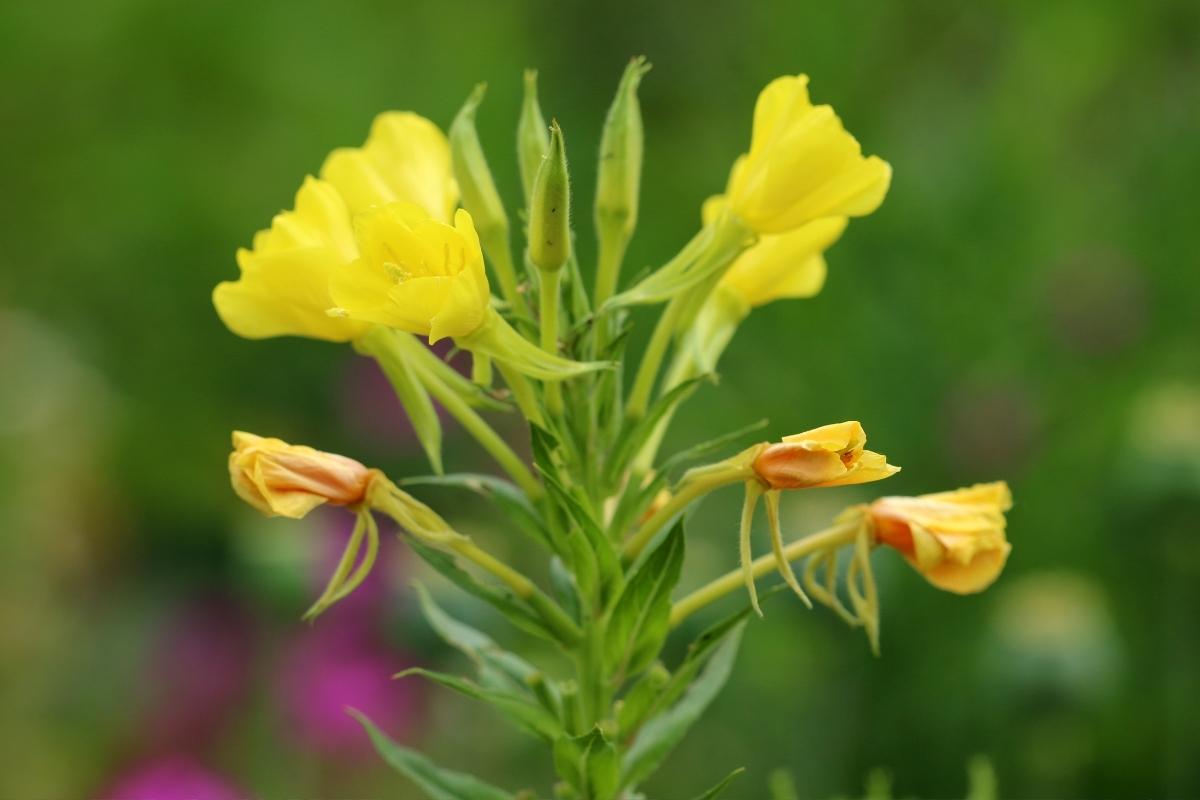
Feverfew (Tanacetum parthenium)
Feverfew is native to Central and Eastern Europe, belonging to the same plant species as chrysanthemum. The plant has white, daisy-like flowers with yellow centers, reaching up to two feet tall.
It’s another medicinal herb with traditional uses, like treating fevers, which is how it received its name. Fever has analgesic, anti-inflammatory, and antipyretic properties, so you’ll find plenty of ways to use it in your herbal apothecary.
Feverfew has a rich history, and we know the ancient Greeks used feverfew to reduce inflammation and menstrual cramps. That’s reason enough to add this adorable perennial plant to your garden and watch the blooms appear from July to October.
Feverfew Benefits
The most common way to use feverfew is to reduce fevers, but that’s not the only benefit of this herb. Studies show that this flower may be used to treat headaches, arthritis, colds, and more. (Studies)
The traditional medicinal uses of feverfew include:
- Treats headaches
- Reduces fevers
- Regulates menstrual periods
- Relieves nausea and vomiting.
Growing & Using Feverfew
When growing feverfew, the most important step is picking a spot with plenty of sun; these plants want six to eight hours daily. Feverfew prefers loamy soil, but you can grow it nearly anywhere on your property.
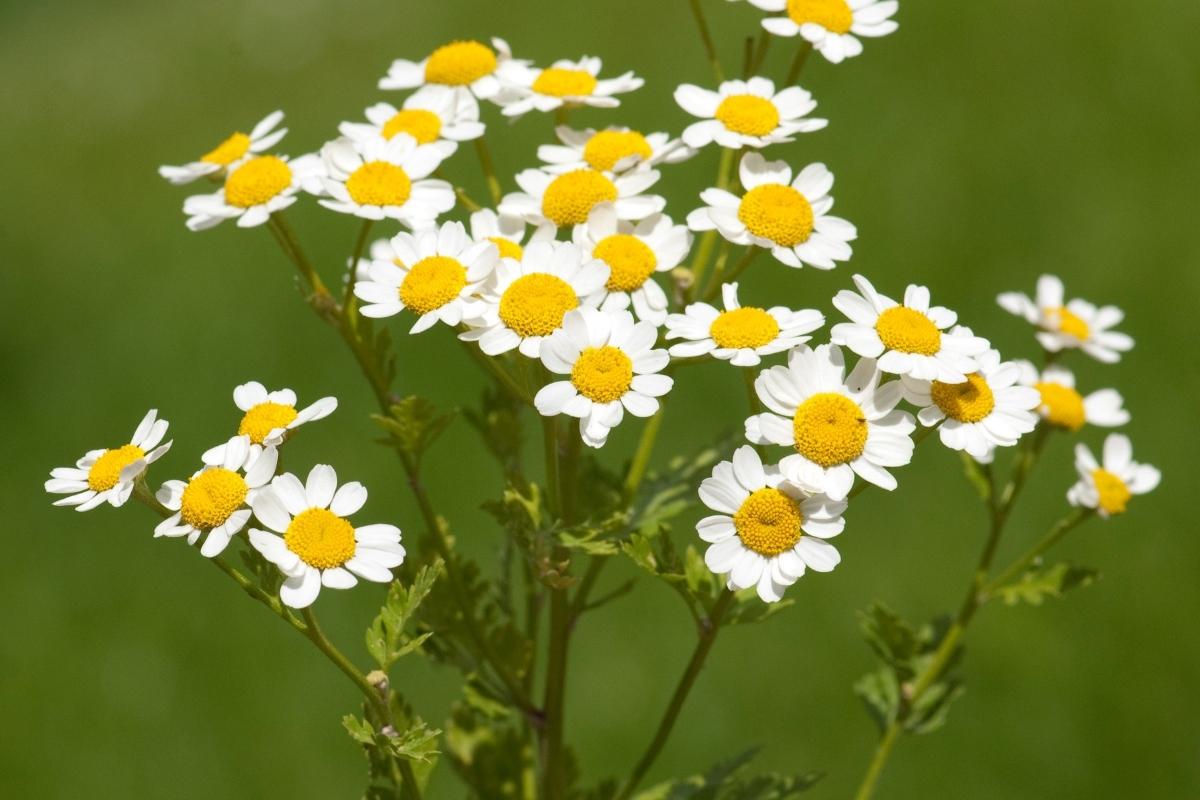
Foxglove (Digitalis lanata)
Foxglove is a gorgeous flower that you can grow in your garden with biennial tubular blooms, so it only lives for two seasons. You’ll want to plant each year so you can enjoy these flowers every summer.
However, many parts of the foxglove plant are poisonous, so it’s best to only use this medicinal flower when directed by a professional. Never self-treat yourself with foxglove!
I’ve included this one for historical context only, but this particular medicinal flower can be deadly toxic, so please don’t use it at home. (It’s still lovely to know it’s an old time medicinal when you walk by the blooms in your garden, even if you never use it yourself.)
Foxglove Benefits
Most of the recommended foxglove benefits come from the roots; this is where most of the medicinal properties are. Some studies indicate that foxglove contains cardiac glycosides, a proven treatment to prevent heart failure. (Studies)
Reminder: It’s not safe to use these without the help of a trusted expert.
The traditional medicinal uses of foxglove include:
- Treats irregular heartbeat
- Relieves asthma
- Heals wounds and burns
- Treats constipation
Growing & Using Foxglove
Foxgloves require full sunlight to grow to full potential, but they tolerate partial shade. They grow the best in well-draining, rich, loamy soil.
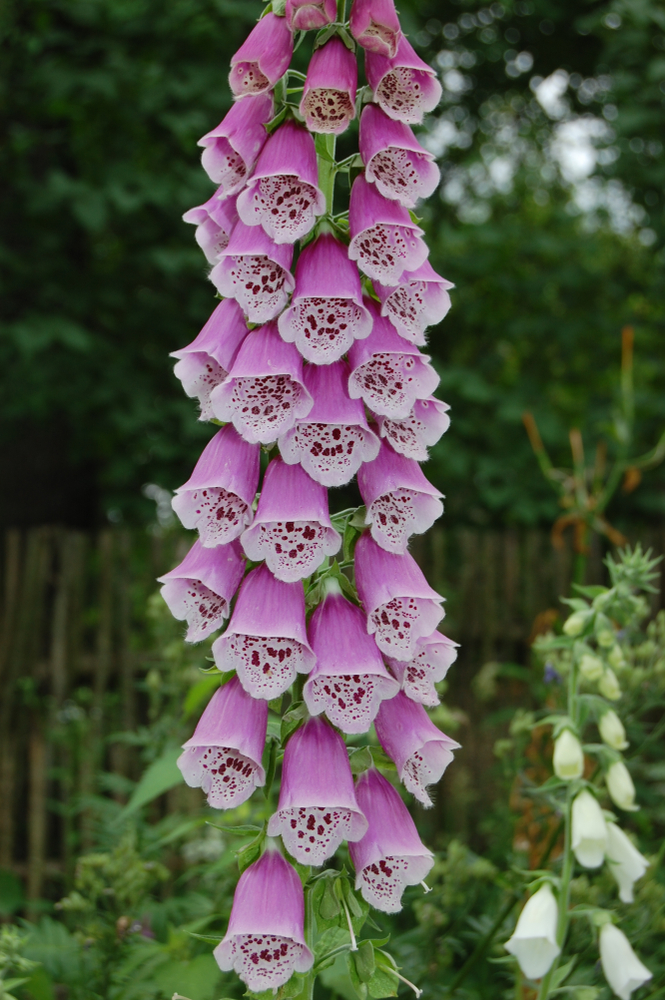
Hawthorn Flowers (Crataegus sp.)
Hawthorn trees are gorgeous trees that typically reach up to 30 feet tall, but they are rarely thin in diameter. You often see these trees in urban settings. These trees produce flowers that eventually turn into tiny berries that also have herbal properties, used to treat high blood pressure and heart failure.
Studies look at the different medicinal properties of hawthorn flowers and how we might use them in herbal remedies. Most studies focus on the use of hawthorn flowers to deter cardiovascular disease.
Hawthorn Flowers Benefits
Most benefits of hawthorn flowers revolve around your heart, but that’s nothing to ignore. Keeping your heart healthy is vital for all of us and avoids other serious problems in the future.
The traditional medicinal uses of Hawthorn flowers include:
- Reduces asthma
- Treats high blood pressure
- Reduces stomach pains and indigestion
- Relieves constipation
- Decreases anxiety
Growing & Using Hawthorn Flowers
Hawthorn trees require full sunlight and well-draining soil to reach optimal growth. This tree tolerates a range of pH ranges and soil types.
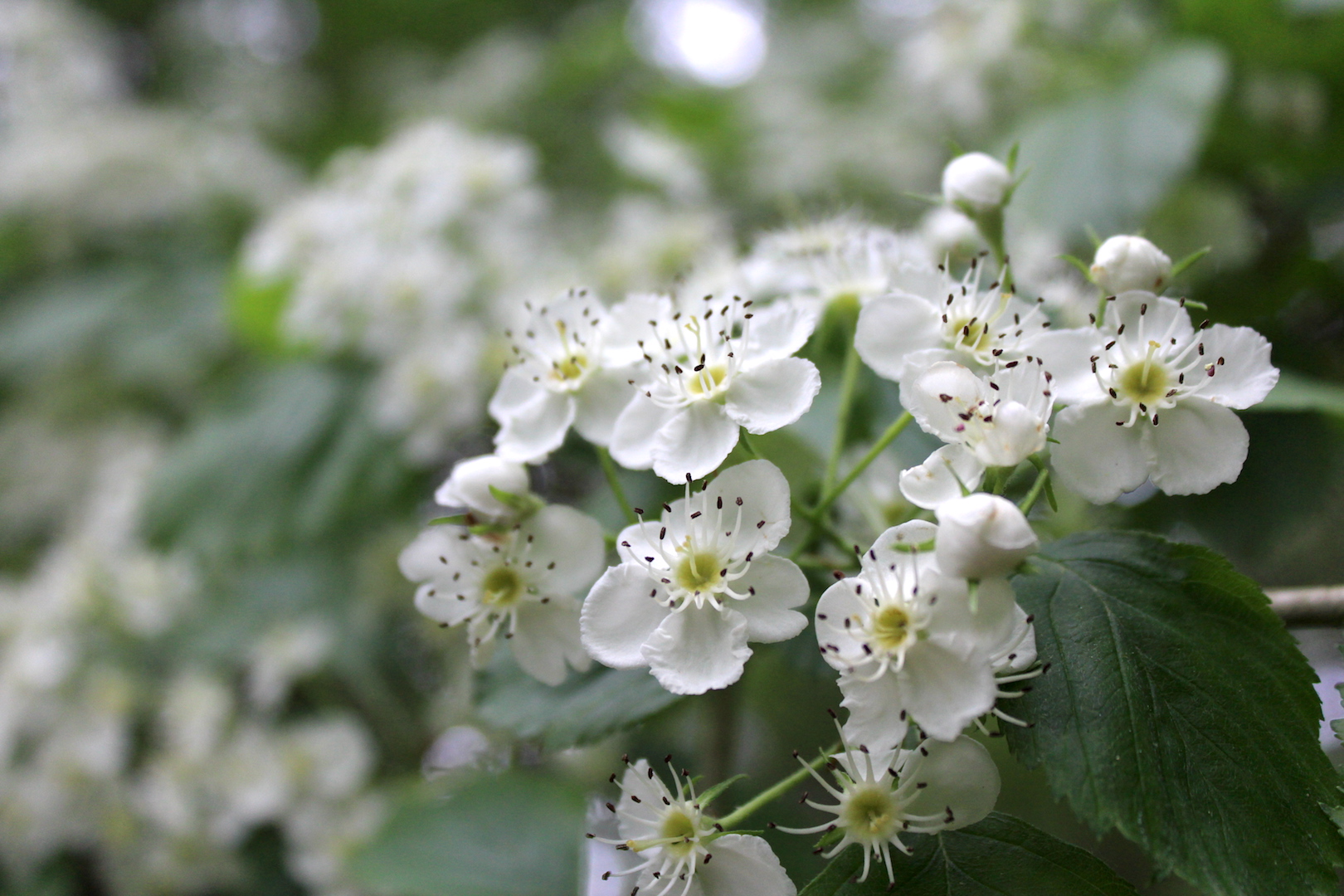
Herb Robert (Geranium robertianum)
You might recognize the plant herb Robert by its nickname “Stinky Bob.” Herb Robert is a pretty ornamental plant with flowers that is known to have medicinal uses. The plant has lacy leaves with five pretty pink petals on the flowers. The flowers are tiny but look beautiful all over the plant.
Many people don’t grow this plant because it’s a sprawling plant. If you fail to control it, it will spread rapidly. Be sure to plant it either in a container or actively control the spread by harvesting regularly.
Herb Robert Benefits
Several studies examined the potential medicinal properties of herb robert. It’s believed to treat kidney and bladder problems, such as inflammation, and it may prevent gallbladder issues, like gallstones, from developing. (Studies)
Historically, herbalists used herb Robert to treat upset stomachs, nosebleeds, and skin irritation.
The traditional medicinal uses of Herb Robert include:
- Alleviates headaches
- Relieves sinus problems and congestion
- Gets rid of a sore throat
- Treats insect bites
Growing & Using Herb Robert
Herb Robert is an invasive species in many areas, but if you want to grow it, you can plant the seeds in spring. They prefer semi-shady to shady areas with loamy yet nutritious soil. It does well growing wild in our woodlands, and we’ve found that it’ll tolerate more than a little shade.
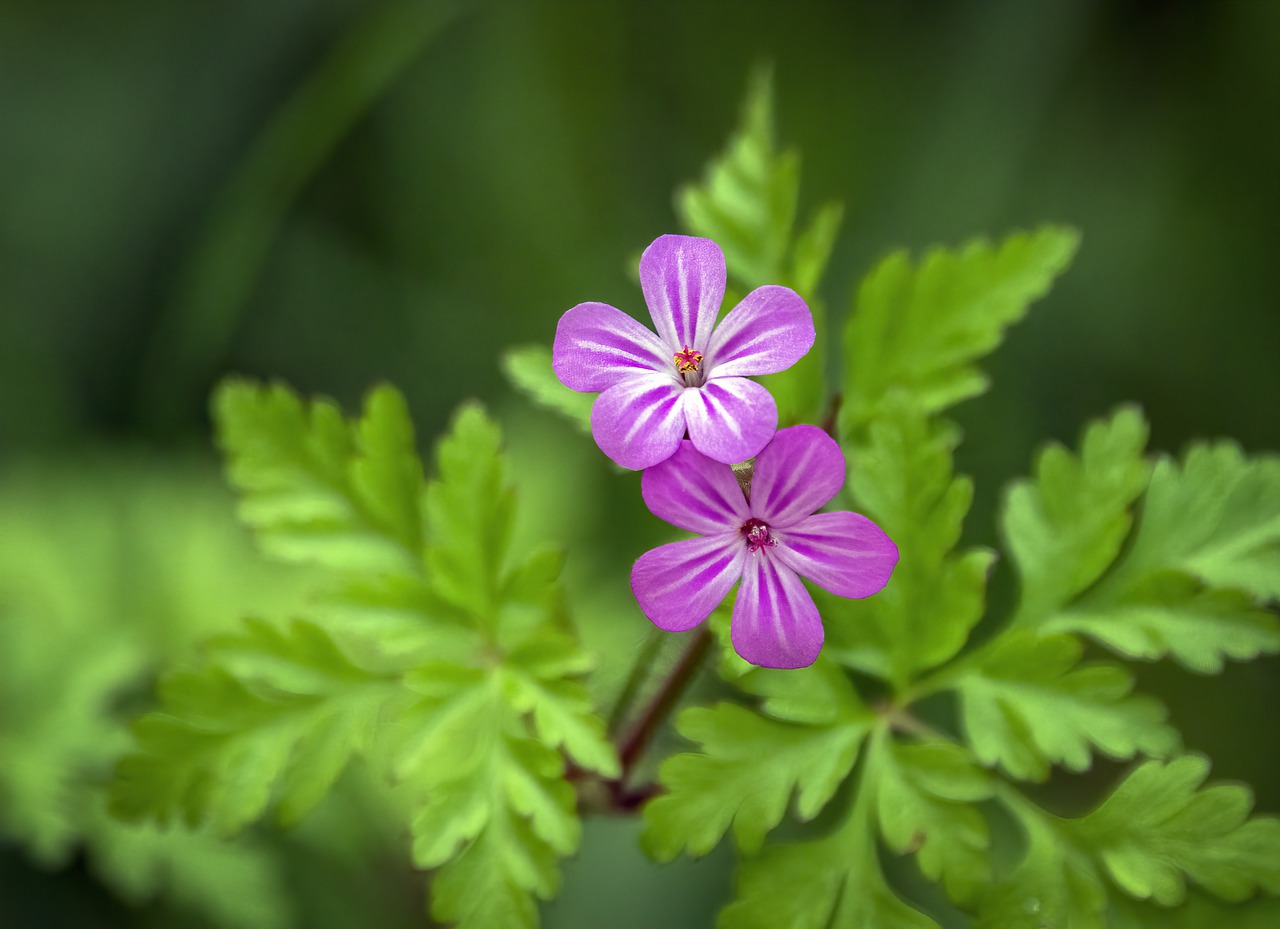
Hollyhock (Alcae rosea)
Hollyhocks are gorgeous flowers to grow in your garden with tall flower stalks often reaching up to nine feet tall. Most people plant them because they look fantastic and striking in your garden, but the flowers are well-known for having herbal properties.
Many people have no idea that this common garden flower is edible, including the leaves and roots. This plant is related to marshmallow plants and is often a substitute for that herb when it’s not available.
However, when using this plant for herbal remedies, be sure to avoid exposing it to heat and alcohol because it will decrease the medicinal properties. Cold infusions are the best bet!
Hollyhock Benefits
Most herbalists use the flowers for their remedies because this part of the flower is best known for treating and preventing breathing disorders, such as asthma. It’s also known to treat skin issues like ulcers and swelling, as well as inflammation.
The traditional medicinal uses of hollyhock include:
- Treating asthma
- Reducing diarrhea and constipation
- Eases eczema and other inflammatory skin conditions
- Soothe inflammation in the mouth and gums
- Ease symptoms of dry cough and hoarse throat
Growing & Using Hollyhock
Growing hollyhocks takes special attention to the soil. The plants require full sunlight with well-draining, rich soil. They need plenty of nutrients in their soil to grow, and the soil cannot be dry. These flowers require plenty of moisture to grow well.
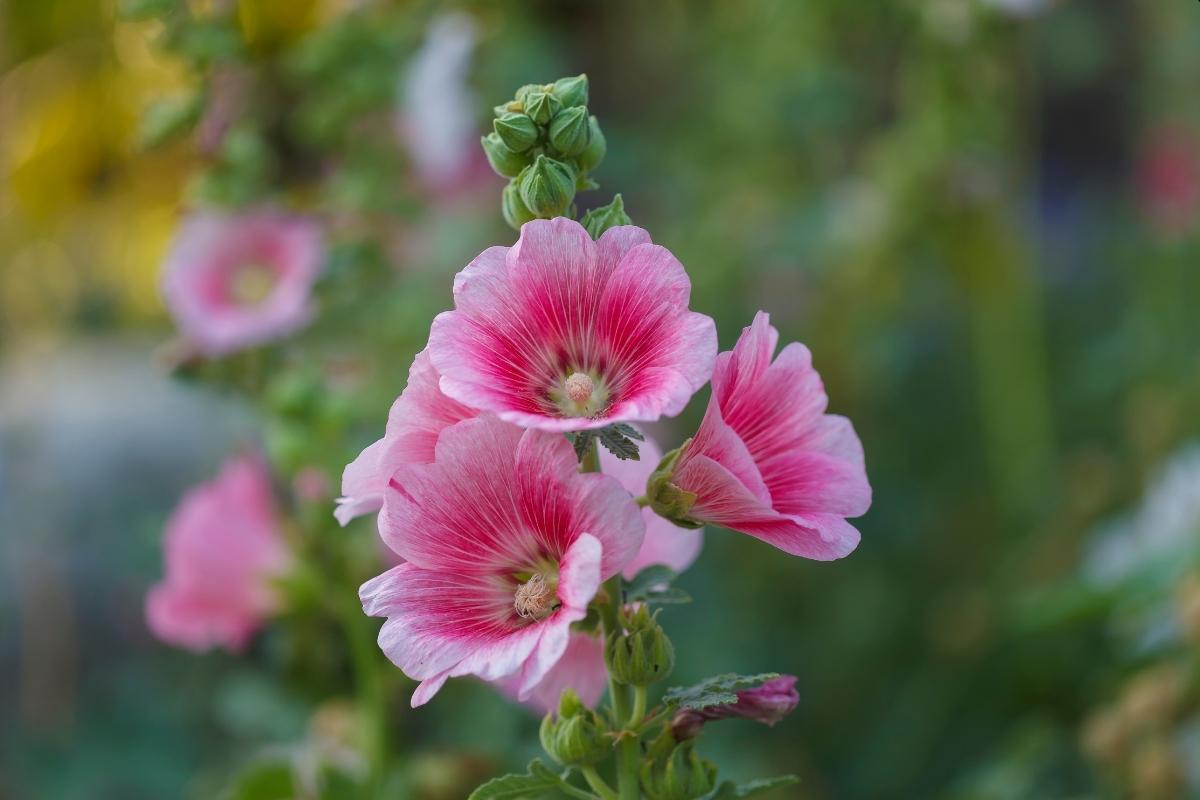
Hyssop (Hyssopus officinalis)
Another flowering herb you might already have in your flower garden is hyssop. This plant has flavorful, pretty leaves and flowering spikes with blue, pink, or red flowers. Not only is this plant quite beautiful, but it’s known for attracting pollinators to your garden.
Hyssop is a rather large plant that continues to spread. Some prefer to grow it in a container for this reason, but hyssop is quite showstopping. So, it’s a great way to fill your garden as well with little work on your end.
Hyssop Benefits
Hyssop is a well-known and studied medicinal flowering plant. Evidence shows that the extracts that come from this plant have many properties, such as antifungal, antibacterial, and antimicrobial properties. It’s suggested in a study that hyssop may combat microbial activity in food-borne pathogens.
Truthfully, this is quite a versatile flower that may be used for a variety of ailments.
The traditional medicinal uses of hyssop include:
- Treats coughing and chest congestion
- Promotes healthy digestion
- Reduces belly aches and other digestive problems
- Reduces toothache pain
Growing & Using Hyssop
This hyssop is a hardy perennial, and you need to start seeds indoors eight to ten weeks before the final spring frost. Germination takes time, so be patient.
Pick a spot with full sunlight and dry soil that drains well. Luckily, these plants have few pests and diseases, so they make excellent companion plants.
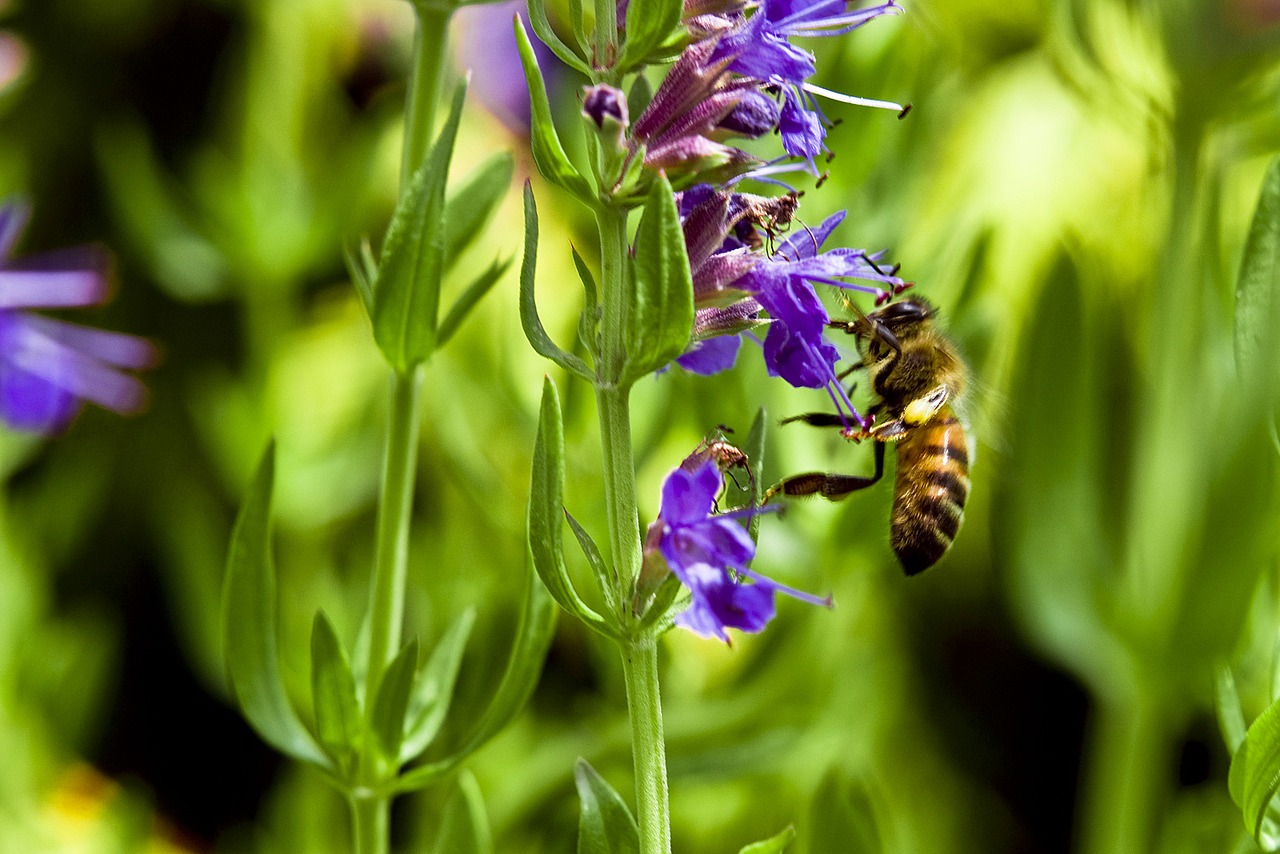
Jasmine (Jasmine officinale)
Most people recognize the scent of jasmine plants; it’s regularly used in body sprays and perfume. It’s fragrant with tropical and warm notes, a popular choice in teas, candles, soaps, lotions, and more. Gardeners often grow jasmine simply due to the local aroma produced as the breeze blows by the plants but this plant only grows in warm climates.
A bummer for those of us in cooler climates.
Jasmine is a well-studied medicinal flower with studies indicating that the plant has antibacterial properties. The flower is the part of the plant most often used for herbal remedies, known for helping individuals relax and decrease their stress. (Studies)
Jasmine Benefits
Most studies focus on the overall aromatherapy benefits of jasmine, but one study indicated that jasmine may help fight some bacterial strains, such as E. coli. This indicates we have more to learn about this lovely flowering plant! (Study)
The traditional medicinal uses of jasmine include:
- Reduces diarrhea
- Improves your memory
- Improves libido
- Decreases stress and anxiety
- Improves overall mood
Growing & Using Jasmine
Jasmine requires a warm, sheltered location to grow along with a support structure with full sunlight. Make sure the soil is well-draining and moderately fertile. These plants often reach up to 15 feet tall, so be sure to pick the right location for these plants.
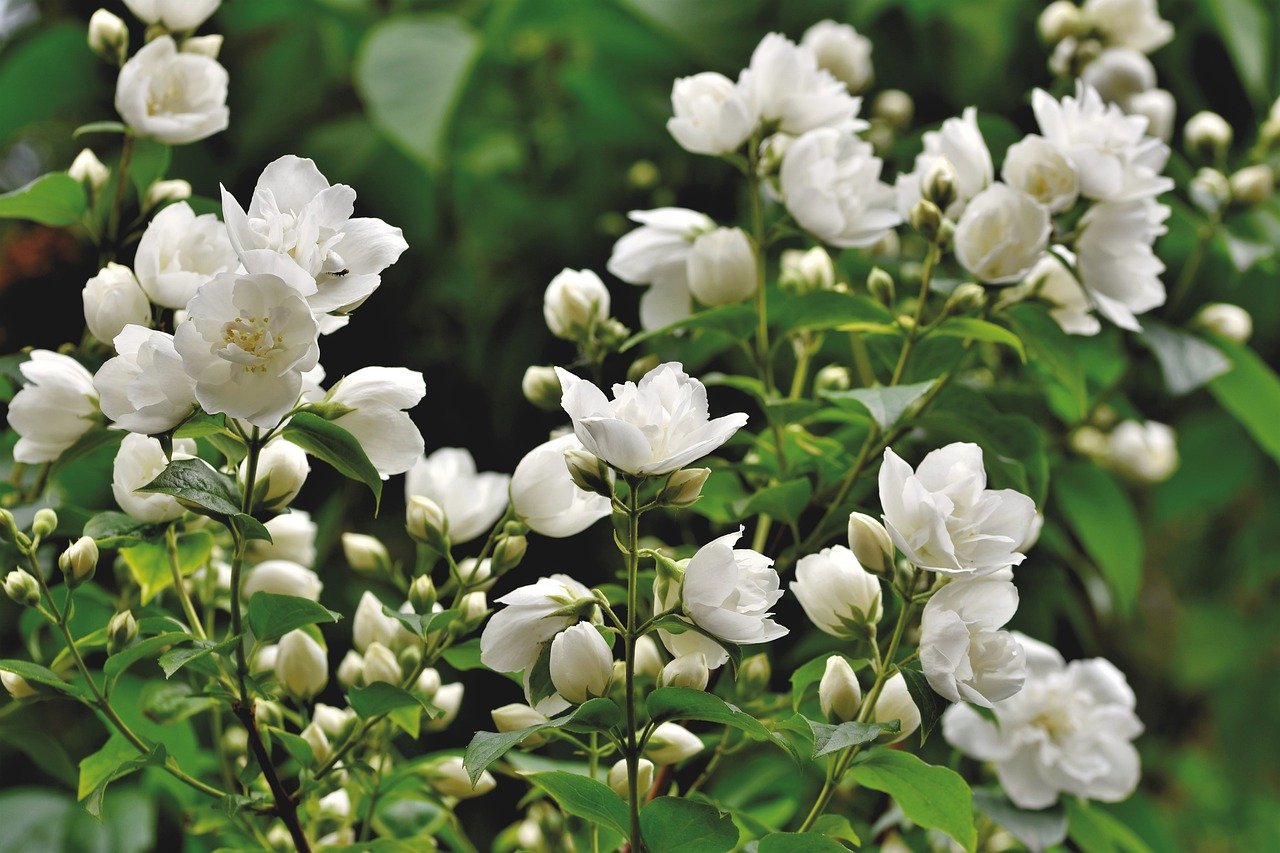
Jewelweed (Impatiens capensis)
Jewelweed is part of the Impatiens family, but it’s not typically a flowering plant you add to your flower garden. It’s a wildflower that grows along streams, ponds, and bogs, attracting pollinators like bees and butterflies to stop at the flowers.
Native Americans used jewelweed in a range of folk remedies such as relieving itchiness and overall pain when applied topically. They used jewelweed to treat poison ivy rashes, skin sores, and skin irritation. This is because jewelweed has anti-inflammatory and anti-histamine properties.
Jewelweed Benefits
Studies indicate jewelweed treats poison ivy dermatitis, something traditionalists knew all along worked. Multiple parts of the plant have medicinal properties including anti-fungal properties that may treat fungal skin infections. (Studies)
One effective way to use this plant is as a fresh plant poultice, but you also can make salves, skin washes, or infusions.
The traditional medicinal uses of jewelweed include:
- Reduces joint pain
- Treats skin rashes and poison ivy
- Treats digestive disorders
- Increases healthy blood flow
Growing & Using Jewelweed
Jewelweed has similar growing needs as other impatiens flowers. They prefer to grow somewhere with partial to full shade rather than full sunlight. The flowers prefer to grow in rich, organic soil, as long as the soil stays moist.
One thing to note is that germinating jewelweed seeds is a bit different than other seeds. They require cold stratification, which nature does for us with the process of winter and frosts, but you need to keep your seeds in the refrigerator for at least two to three months.

Lavender (Lavandula angustifolia)
Nearly everyone recognizes lavender as one of the top medicinal flowers; if you need a relaxing scent in your house, lavender is undoubtedly the way more people go. Lavender originates in the Mediterranean region and produces beautiful purple-blue flowers with a strong scent we all love.
That’s why lavender is popular for body and home products like candles, lotions, and soap.
The flowers have a calming effect on humans, which is why this medicinal plant is best known for reducing anxiety and stress. It doesn’t have a sedation effect, so it’s safe to use regularly.
Lavender Benefits
We know that lavender is great for stress and anxiety, but evidence shows that lavender treats insomnia as well. So, if you need to improve your sleep quality, lavender is a great way to do so.
The traditional medicinal uses of lavender include:
- Treats insomnia
- Reduces blood pressure
- Reduces menopausal hot flashes
- Treats acne inflammation
Growing & Using Lavender
It’s possible for those in cooler climates to grow lavender as an annual, but it grows best and prolifically in warm climates as a perennial. That makes the most sense since it originates in the Mediterranean region.
If you live somewhere warm, growing lavender is quite easy since it grows well in most soil types. Just make sure the soil drains well, and the plant receives at least six to eight hours of sunlight.
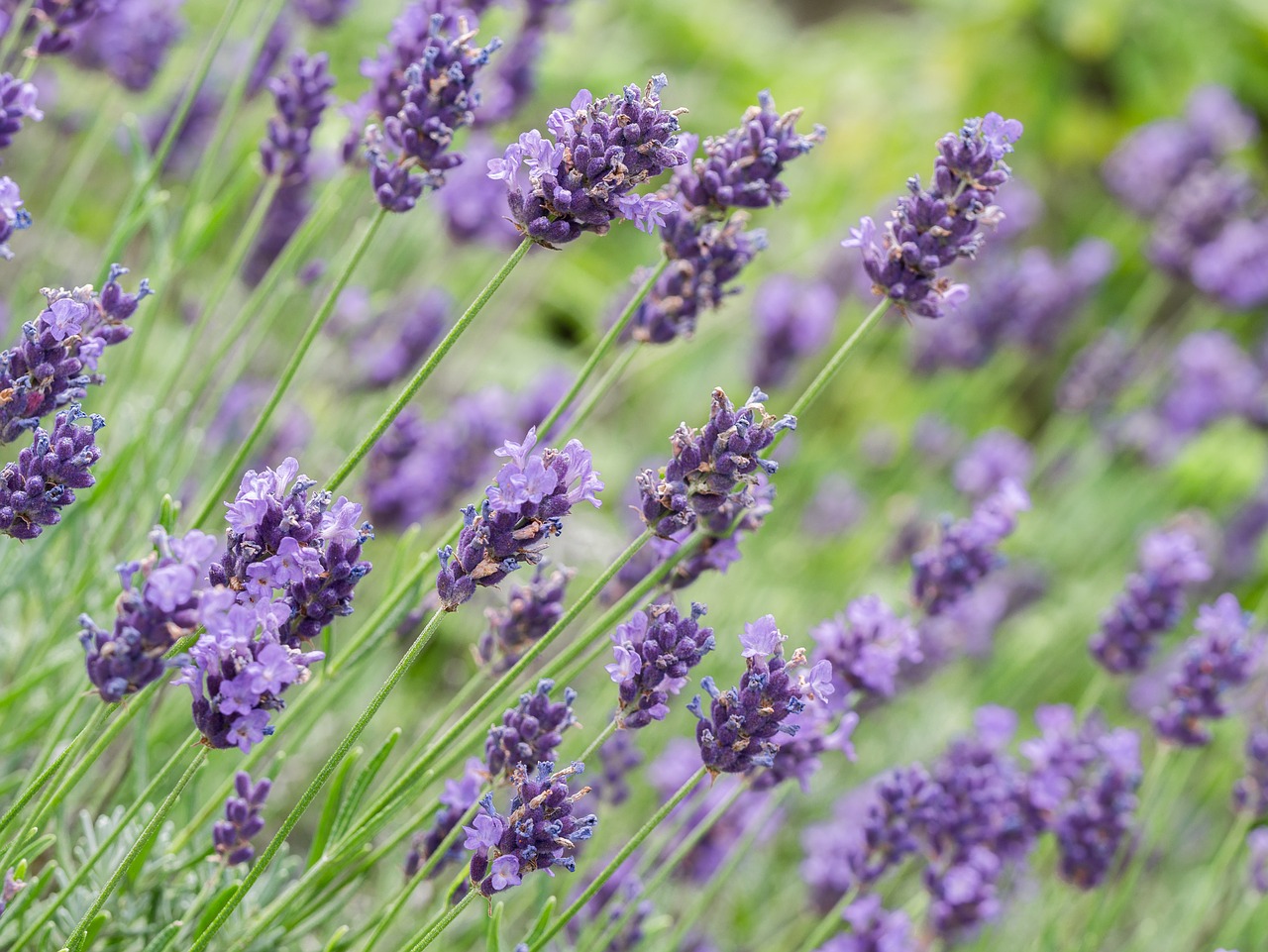
Marshmallow (Althaea officinalis)
No, I’m not talking about the marshmallows you put into your s’mores over the campfire. Marshmallow is an herbal plant used historically to flavor and thicken marshmallow root; this contains mucilage that gives marshmallows a fluffy texture we all love.
Nowadays, marshmallows are made with gelatin, but long ago marshmallows contained properties that treated sore throats and coughs.
Historically, these plants had many uses for herbal remedies from treating pain to reducing inflammation. We know herbalists used marshmallow plants to treat dry coughs and bronchitis as well; it’s a versatile plant.
Marshmallow Benefits
Marshmallow is one of my favorite medicinal flowers to keep in my apothecary. Studies show that marshmallow flowers soothe irritated mucous membranes, treat asthma, bronchitis, sore throats, and coughing. This is because the plants contain high natural mucilage content. (Studies)
The traditional medicinal uses of marshmallow include:
- Relieves sore throats
- Treats heartburn and stomach aches
- Heals eczema
- Relieves sunburns
- Helps with coughs and sore throats
Growing & Using Marshmallow
Most gardeners may grow marshmallow plants in their garden, and the tall flower spikes look gorgeous in your garden beds. The flower spikes reach up to six feet tall, making quite an appearance next to other plants.
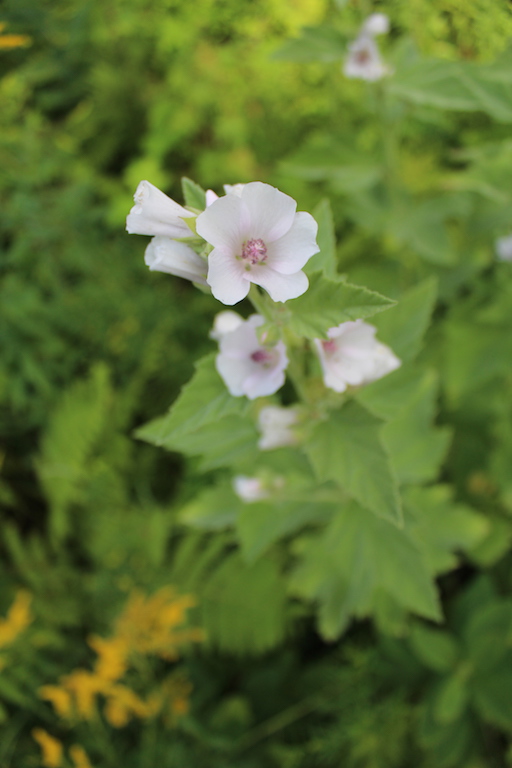
Motherwort (Leonarus cardiaca)
Many people have never heard of motherwort; it’s a perennial herb that you find in streams or rivers since it’s most typically a wild plant. However, herbal gardeners may want to add this plant to their gardens since it’s perfect for ornamental landscapes. The plant reaches up to four feet tall, blooming in the middle to late summers.
We have motherwort grow in our garden, and it’s massive. The plant is over six feet tall and four feet wide in its second year of growth. Pollinators flock to this plant, so it’s great to plant near your vegetable garden.
Motherwort Benefits
Motherwort contains herbal properties and compounds, such as flavonoids, that give this perennial plant various uses for herbalists. Clinical trials looked at this herb and confirmed that the plants have antibacterial, antioxidant, anti-inflammatory, and analgesic properties. (Trials)
Motherwort contains the chemical alkaloid leonurine, which dilates the blood vessels in your body and reduces menstrual cramps. It also has a relaxing effect, so women suffering from premenstrual syndrome find relief with this herb. (Evidence)
The traditional medicinal uses of motherwort include:
- Reduces gassiness
- Treats skin itchiness and shingles
- Helps with high blood pressure and heart palpitations
- Relieves anxiety and tension symptoms
- Helps with PMS symptoms and painful menstruation
Growing & Using Motherwort
Motherwort grows well in any type of sunlight, so if you have space in your garden, I bet you have a spot for this herbal plant. It adapts to most soil types, but the ideal soil type is rich with a pH range of around 7.7.
Once established, the plant is hardy and drought-tolerant, and it’s known for rarely having pest problems. So, if you’re a new gardener, this is an excellent plant to grow.
- How to Grow & Use Motherwort
- How to Make Motherwort Tincture
- Motherwort & Lemon Balm Brew
- Motherwort Infused Oil
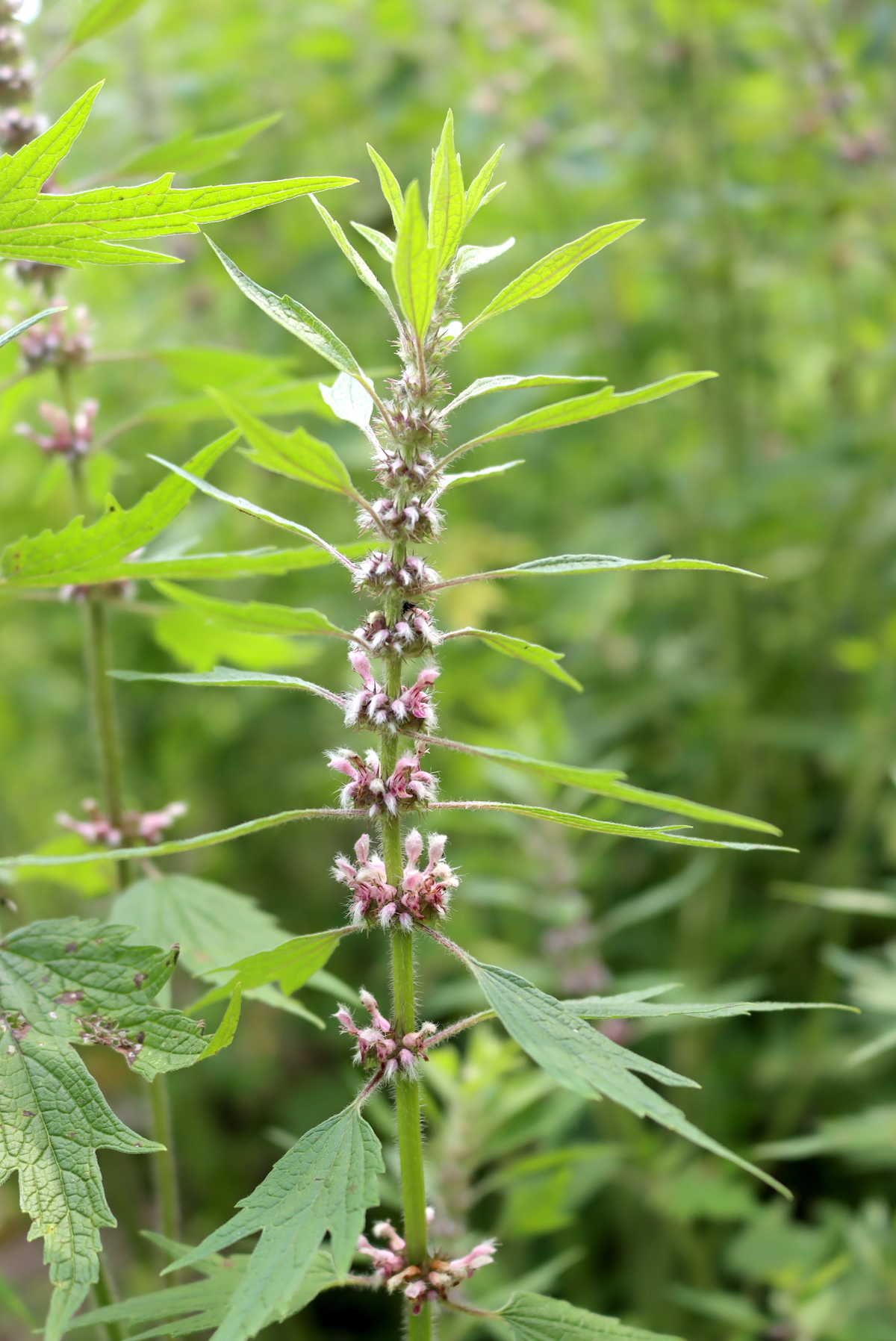
Nasturtium (Tropaeolum sp.)
A common annual garden flower, these add color to vegetable gardens all over the world. Most people know them as an edible flower, and use them in salads as well as other nasturtium recipes.
Nasturtiums are also medicinal, though few people know that they’re more or less accidentally growing medicinal flowers.
Nasturtium Benefits
Since it’s believed to have antibacterial, antifungal, and anti-viral properties, nasturtium is used to treat a number of different issues.
Traditionally, nasturtiums are used to treat:
- Cold symptoms
- Coughs and Bronchitis
- Urinary Tract Infections (UTIs)
- Minor Swelling and Topical Injuries
- Minor skin and nail fungal infections
Growing & Using Nasturtium
If you want to try some nasturtium medicinal uses, here are a few great places to start.
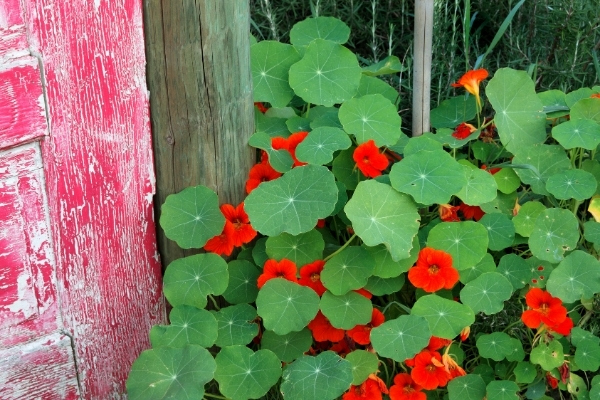
Passionflower (Passiflora sp.)
Passion flowers are popular in ornamental gardens nearly everywhere since they grow well in USDA zones 5 to 11. They produce pretty flowers in various colors, but these exotic flowers only stay in bloom for a few days before falling off the plant.
That’s a bit of a bummer, but if you have multiple flowers in your garden, they’ll bloom at different times, creating quite a showcase for you. Depending on where you live, they grow as both annuals and perennials, and since there are over 500 species of passion flowers – seriously – you’ll find a variety that works great for your garden.
Passionflower Benefits
Few studies examine all the benefits of passionflower as a medicinal flower, but one study indicated that passionflower extract may help improve the quality of sleep. The results showed that passionflower extract increased the overall sleep time by decreasing wakefulness and periods of rapid eye movement. (Study)
The traditional medicinal uses of passionflower include:
- Reduces anxiety symptoms
- Improves short-term memory
- Improves the quality of sleep
Growing & Using Passionflower
These flowers require full sunlight, but if you live in a hot summer climate, some afternoon shade is beneficial. The mature plants often grow over 10 feet tall and 8 feet wide. Make sure the plant has well-draining, fertile soil, but be careful because these flowers are rampant growers and are invasive in some areas.
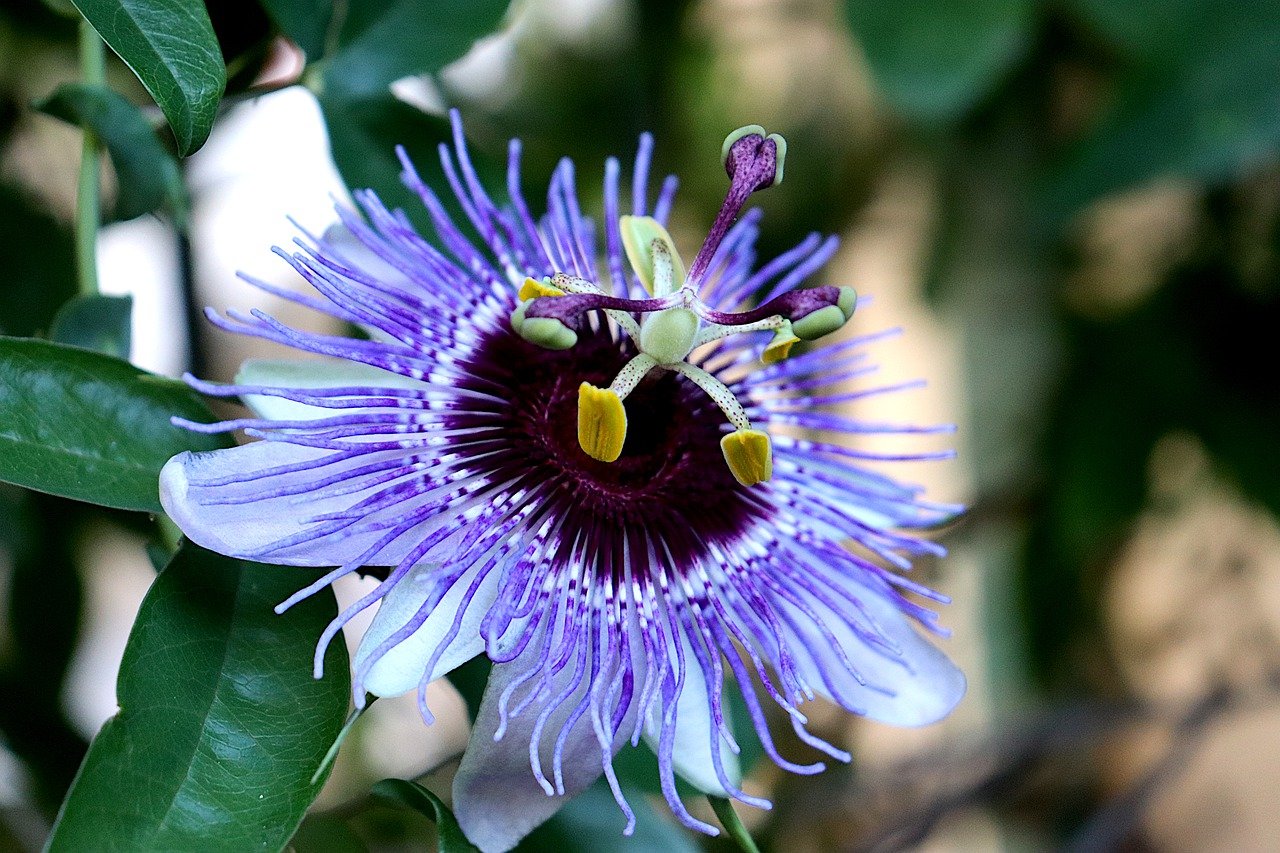
Peony (Paeonia sp.)
Most people grow peonies for their beautiful flowers, but these medicinal flowers have a long history in traditional Chinese medicine. The flowers are known for being a flowering herb, treating arthritis, depression, and asthma. It may hold anti-inflammatory properties as well (Studies)
Peony Benefits
Peonies block chemicals that cause pain and swelling, and evidence suggests blood clotting. So, you may be able to use peonies to treat menstrual cramps, coughing, and other ailments. Historically, it treated depression and arthritis.
Herbalists used this plant in a variety of ways, such as cold infusions, decoctions, dried herbs, capsules, and more.
The traditional medicinal uses of peony include:
- Promotes liver health
- Treats viral hepatitis
- Treats rheumatoid arthritis
- Relieves muscle spasms and menstrual cramps
- Supports memory and mood
- Calms coughing and asthma attacks
Growing & Using Peony
These gorgeous flowers require full sunlight and neutral pH soil range. You may grow these flowers in USDA hardiness zones 3 to 8. Make sure the plants receive full sunlight, but they may bloom with half a day of sun. They require shelter from strong winds, so pick a spot wisely for them.
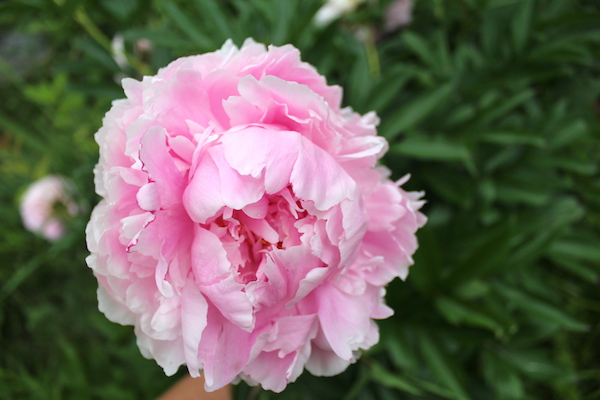
Pineapple Weed (Matricaria discoidea)
Pineapple weed may grow in your yard without you realizing since this is typically considered a weed in most regions. It’s invasive and grows nearly anywhere like the cracks in sidewalks.
At first glance, it’s easy to confuse pineapple weed with wild chamomile since the flowers look similar. However, once you get closer, you can identify the plant by its lacy foliage with small, yellow flowers. The plant often reaches one foot tall, and it gives off a slight aroma of pineapple.
Sometimes, foragers put the dried or cooked pineapple weed flower heads into trail mixes. They give you a pineapple burst, and they taste quite delicious!
Pineapple Weed Benefits
One exciting find in recent years is that pineapple weed contains many of the same compounds as German chamomile. So, these plants may look alike and share similar compounds; evidence shows this weed has calming properties as well!
Pineapple weed works for pain relief as well. The active compounds numb areas quickly and give you relief from chronic or acute pain. Since the herb has antimicrobial and antibacterial properties, it also helps with skin problems like psoriasis and eczema.
The traditional medicinal uses of pineapple weed include:
- Encourages healthy sleep
- Reduces insomnia
- Treats the common cold
- Acts as a mild pain reliever
- Reduces anxiety and stress levels
Growing & Using Pineapple Weed
Since pineapple weed is an invasive weed in many areas, it grows almost anywhere. All you need is ample sunlight; it even grows in compact soil, so you know the plant isn’t picky about the type of soil in your garden.
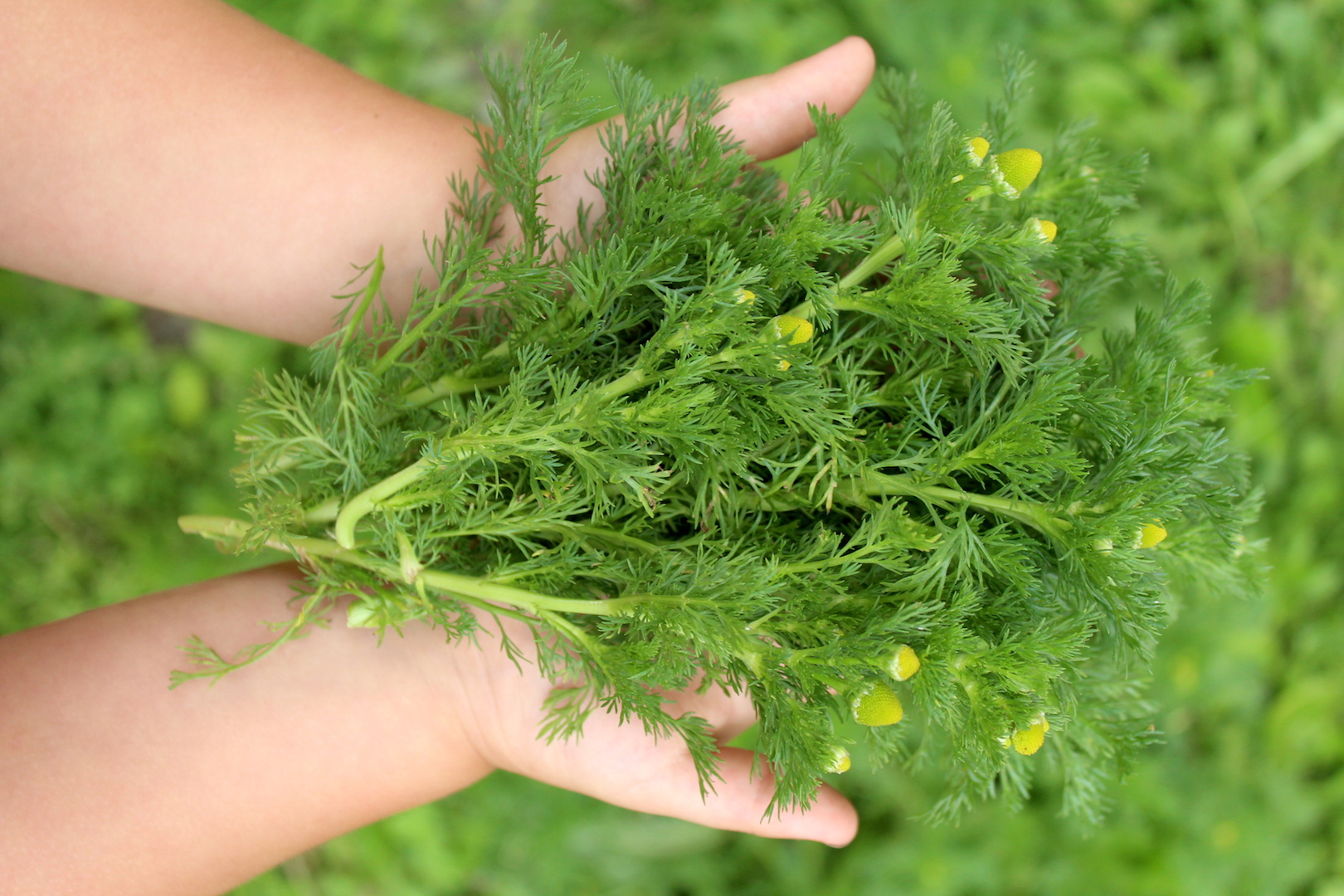
Queen Anne’s Lace (Daucus carota)
Some people refer to Queen Anne’s lace as wild carrot since the flowers belong to the same family as carrots. These are a classic flower to add to your garden; they have a vintage feel since these flowers are often found in cottage gardens. They’re actually considered a weed by most people, so that shows how easy they are to grow.
The plants are easy to spot, but they look very similar to poison hemlock (which is deadly toxic).
Be aware because more people than ever are noting that poison hemlock has made its way into their region. It looks similar so I suggest only harvesting the ones you planted. Here’s a guide to telling the difference between queen Anne’s lace and deadly poison hemlock.
Queen Anne’s lace reaches up to six feet tall when grown in ideal conditions, but most commonly it’s around 3 feet tall. The lacy flowers in clusters and fern green foliage are easy to spot and look great towards the back of your garden to add height.
Queen Anne’s Lace Benefits
We know historically Queen Anne’s lace acted as a contraceptive when taken at the right time in a woman’s menstrual cycle. During wars, the plant treated soldiers’ wounds, but that is close to the only evidence we have of the benefits of this plant.
One study examined how this plant may be used in herbal remedies, and they showed the plant may be used to treat coughs and diarrhea. It also has potential as an antiseptic agent, which is why it may have worked so well during the American Civil War for wounds! (Study)
The traditional medicinal uses of Queen Anne’s Lace include:
- Relieves muscle cramping
- Reduces gassiness
- Flushes toxins out of your body
- Stimulates your thyroid
Growing & Using Queen Anne’s Lace
This plant may look complicated to grow, but all you have to do is cast the seeds on the ground. The seeds will germinate and grow, and these are overall low-maintenance plants.
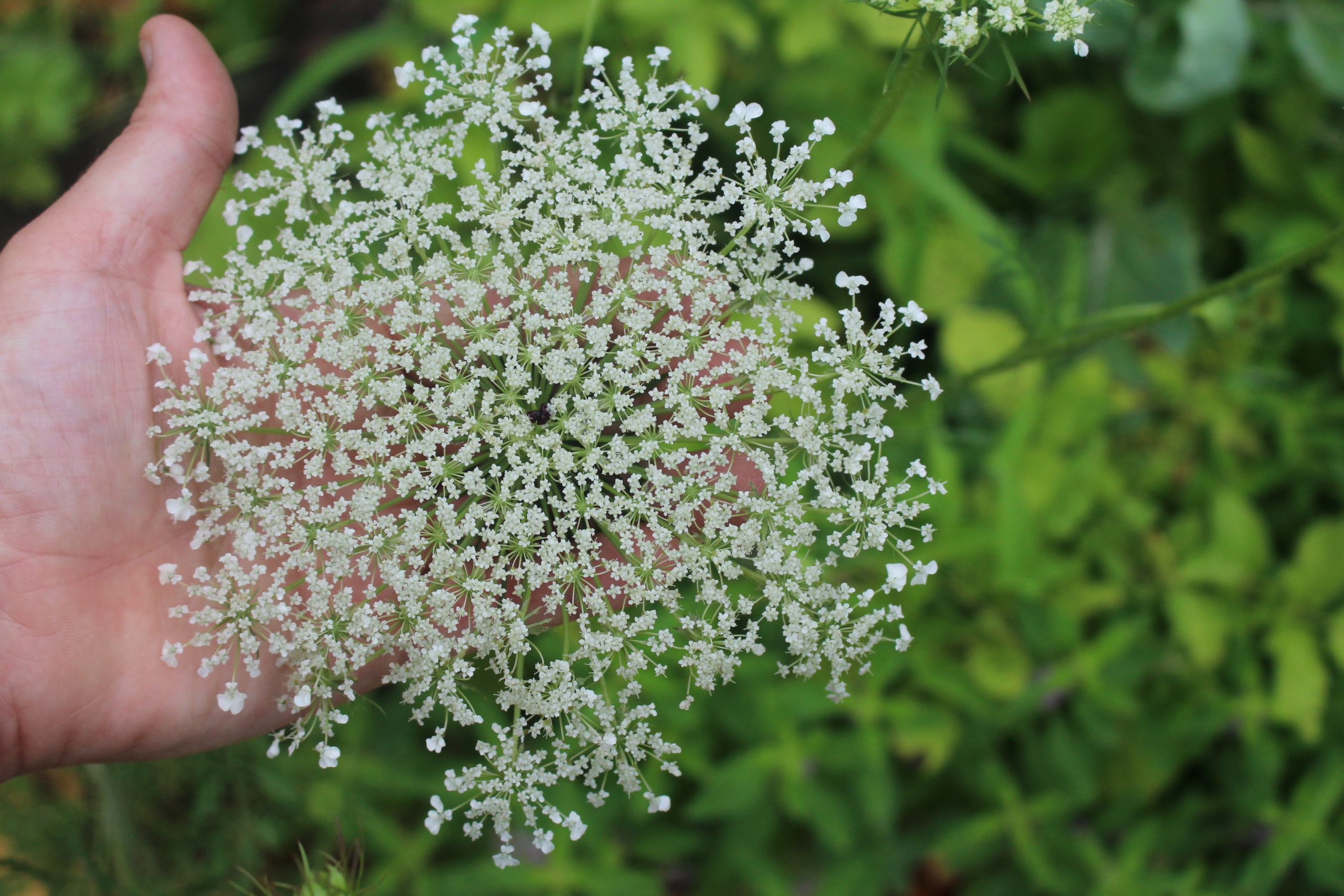
Rose (Rosa sp.)
Roses are best known for being symbols of love and romance; that’s why rose sales skyrocket around Valentine’s Day. They also are one of the most popular flowers in garden beds, especially in cottage gardens.
The petals are most often used in herbal remedies, and rose hips – the fruits of rose bushes – are edible as well. They appear before the blooms, and some use rose hips for immune-boosting teas or even rose hip ketchup!
Rose Benefits
Classic uses for roses include treatments for skin conditions, including reducing inflammation of the skin. Roses soothe skin irritation, rosacea, and eczema while improving your overall skin complexion.
Some studies indicate roses may help reduce anxiety, depression, and stress, so we know that studying is needed to learn how to use these medicinal flowers. (Studies) This plant family also has other properties like antibacterial, antioxidant, relaxant, and more. (Studies)
The traditional medicinal uses of roses include:
- Soothes irritated skin
- Improves your overall skin complexion
- Soothes sore throats
- Treats pink eyes
- Helps minor skin wounds faster
- Reduces anxiety and depression
Growing & Using Rose
Some gardeners feel roses are complicated to grow. Picking a sunny location is crucial to successfully growing roses, and the soil needs to be rich and well-draining. Rose plants require regular watering and fertilization along with yearly pruning to ensure proper growth.
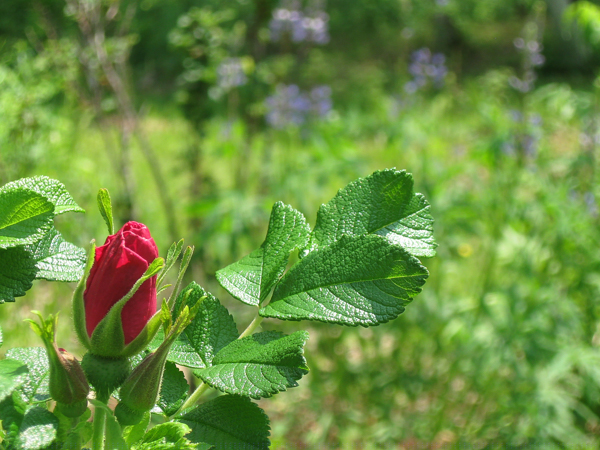
Saint John’s Wort (Hypericum perforatum)
Saint John’s Wort is a well-known herbal flower that grows in USDA zones 3 to 10. The small shrub blooms in midsummer until fall with pretty little yellow flowers, and then, in the fall, the shrub fills with berries.
This medicinal herb has been studied through various trials, and several indicate that St. John’s wort is an effective anti-depression treatment. Those suffering from anxiety and depression may find relief from this flower.
Saint John’s Wort Benefits
Many people suffer from anxiety and depression in our world today, and this herb is an excellent natural treatment. It helps to improve your mood, and people take it regularly through capsule or tea form. (Evidence)
A lot of evidence shows this herb has promise in treating various conditions. The herb helps relieve physical and emotional symptoms of PMS, reduce cramps, relieve breast tenderness, and more.
The traditional medicinal uses of St. Johns Wort include:
- Treats depression
- Reduces anxiety
- Treats PMS symptoms
- Reduces viral infections
Growing & Using Saint John’s Wort
Nearly any gardener may grow St. John’s wort in their garden since it grows in USA zones 3-10. It grows best in shaded locations, and the plant isn’t picky about soil type. These plants grow best in sandy, clay, rocky, and other soil types, so you don’t have to worry about your soil not being good enough.
Even beginner gardeners can grow St. John’s wort!
(Be aware that St. John’s Wort is restricted in some states, as it can be invasive in some regions.)
- St. John’s Wort Growth & Plant Care
- St. John’s Wort Oil
- St. John’s Wort Salve
- St. Johns Wort Tincture
- Saint John’s Wort Tea
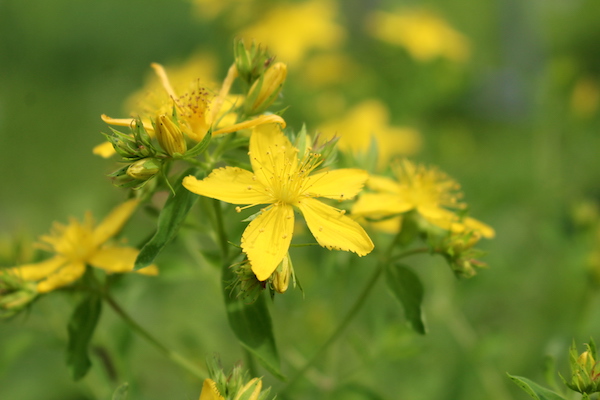
Self Heal (Prunella vulgaris)
A common lawn weed, self-heal is known by many names that imply healing benefits. They include heal-all, woundwort, and carpenters herb…all of which imply that this medicinal flower has wound healing properties.
It’s common throughout the world, and many different cultures have traditional remedies that use self-heal for all manner of ailments.
Self Heal Benefits
As a member of the mint family, self-heal has many of the same properties as other mint family herbs. Namely, it’s anti-inflammatory and antimicrobial.
Self-heal is traditionally used to treat:
- Minor cuts and scraps
- Throat infections
- Stomach Upset and Inflammation
It’s also under investigation for its potential anti-cancer effects, and for helping to prevent complications with diabetes (source).
Growing and Using Self Heal
Few people actually intentionally grow self-heal, it just more or less appears in lawns as an attractive (though weedy) low-growing purple flower. It tolerates being mowed and is honestly pretty hard to kill.
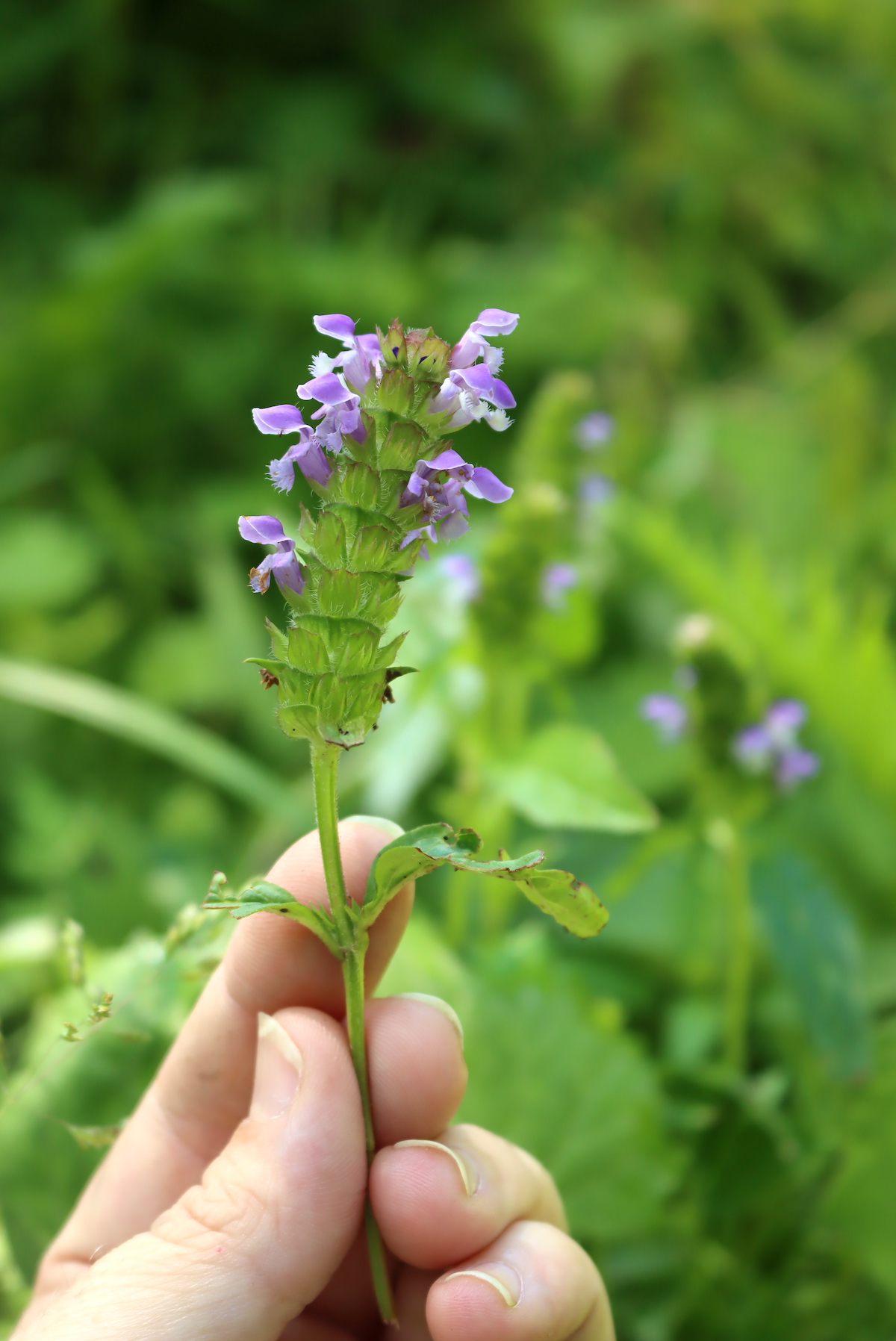
Tulsi (Ocimum tenuiflorum)
You may recognize Tulsi by the names holy basil or sacred basil. It’s a perennial tropical plant you can grow nearly anywhere, even if you don’t live in a tropical region, but it may not be a perennial plant in your region.
Tulsi Benefits
Some studies focus on the different benefits of tulsi on humans, including how it helps regulate glucose levels and blood pressure. This plant includes adaptogens, a substance that helps your body adapt to stress. So, it goes to reason that this plant helps decrease stress and anxiety. (Studies)
The traditional medicinal uses of tulsi include:
- Reduces inflammation
- Ease anxiety and stress
- Kills fungal infections
- Treats and heals minor wounds
Growing & Using Tulsi
Chances are you won’t find tulsi at your local garden nursery, so the best bet is to grow this plant by seeds. Start these seeds indoors six to 12 weeks before the final frost date in your region, and make sure you keep the seed trays warm. That’s how they germinate the best.
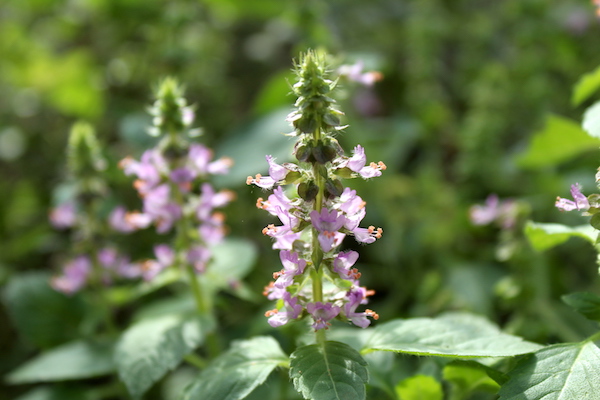
Valerian (Valeriana officinalis)
Valerian is quite a powerhouse medicinal flower because it has potent qualities, and it makes an excellent flower to put into your garden. These plants produce pale pink and white flowers with long leaves, but the part of the plant with the most medicinal properties. The flowers are used as well, but most herbalists grow this plant for their roots.
Valerian is a plant native to Europe and Asia, but it also grows in North America. It has a long history since ancient Greece and Rome when this herb was used to treat insomnia, fatigue, and stomach cramps.
Valerian Benefits
Studies focus on valerian’s properties to improve sleep quality. Clinical trials indicated that valerian had an 80% chance of improving sleep. It’s a known remedy for insomnia, and it’s a safe alternative to taking prescription sleep medications. (trials)
The traditional medicinal uses of valerian include:
- Treats insomnia and anxiety
- Acts as a natural sedative and pain reliever
- Relieves headaches
- Reduces hot flashes
Growing & Using Valerian
Valerian grows best in average, well-draining soil and full sunlight, but it may tolerate partial shade. These plants are extremely cold hardy, and they die back to the ground in winter, emerging in the spring again.
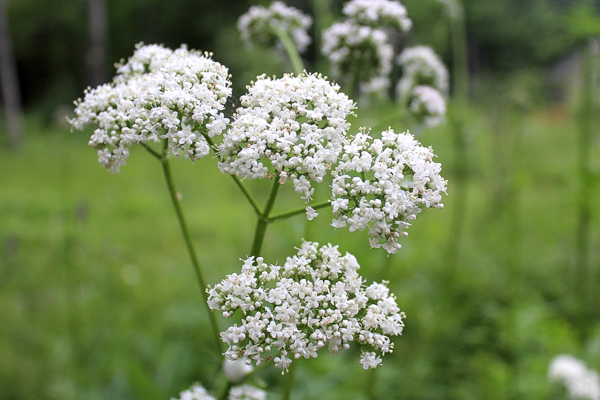
Veronica (Veronica sp.)
A popular low-growing ground cover, veronica plants were especially common in gardens in the Victorian era. They grow wild all over the world, and their other common name “speedwell” gives a hint that they’re also a medicinal flower.
The plants themselves are edible, along with the flowers.
Veronica Benefits
Studies show that veronica plants have anti-inflammatory and wound healing properties, and they’re also anti-microbial against some strains of foodborne illness. They’re traditionally used to treat rheumatism and topical injuries, but they’re also currently under investigation for their potential anti-cancer properties.
The traditional medicinal uses of veronica include:
- Treat minor skin wounds and inflammation
- Systemic anti-inflammatory for joint pain (specifically rheumatism)
- Respiratory issues like cough and congestion
Be aware that there are a lot of different species of Veronica, and it’s hard to know exactly what type of Veronica was meant when it was used historically.
Growing & Using Veronica
Veronica is generally a carefree plant that will readily self-sow. In many places, it grows wild, and some even consider it a ‘weed’ on their lawns. It’s a shame since this truly is a beautiful medicinal flower.
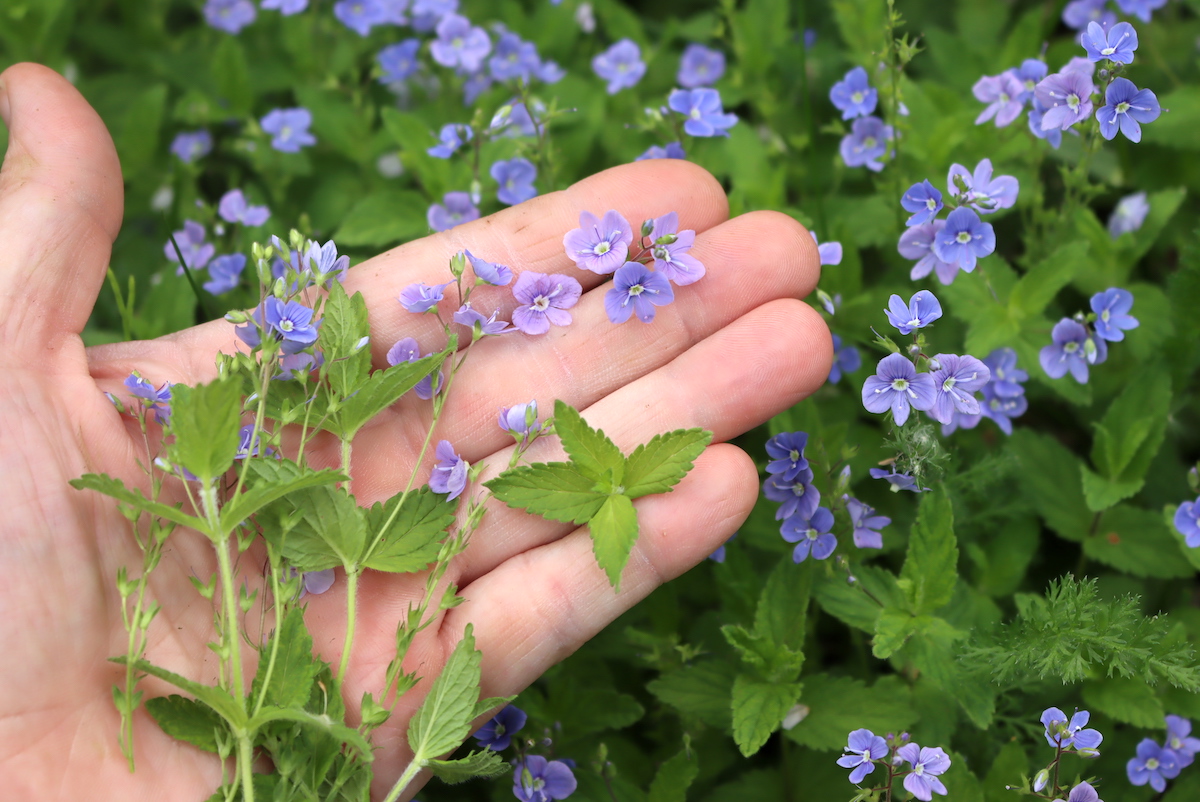
Violets (Viola sp.)
Most people recognize violets since they dot your yard throughout the spring. It’s easy to assume these wild flowers are weeds, but they have medicinal purposes. You may want to let them grow wild, or you may plant them in your garden in a sunny location.
Both the leaves and the flowers of violets have medicinal properties, and they’re edible! You may toss them into salads, and we make violet jelly as a special treat.
Violet Benefits
Multiple studies indicate that wild violets have antibacterial and antifungal properties. Herbalists make various herbal remedies with these flowers, such as poultice, salves, and infusions.
The traditional medicinal uses of violets include:
- Treats coughs and bronchitis
- Reduces swollen lymph nodes
- Relieves hemorrhoids
- Eases dry and chafed skin
- Treats bug bites and eczema
Growing & Using Violet
It’s possible to grow violets if they don’t grow wild in your yard. They tend to self-seed and come back each year. You can plant violets anytime in the spring, and they enjoy light shade but thrive in sunny locations. While violets tolerate all soil types, they prefer well-draining and moist area with plenty of rich matter.
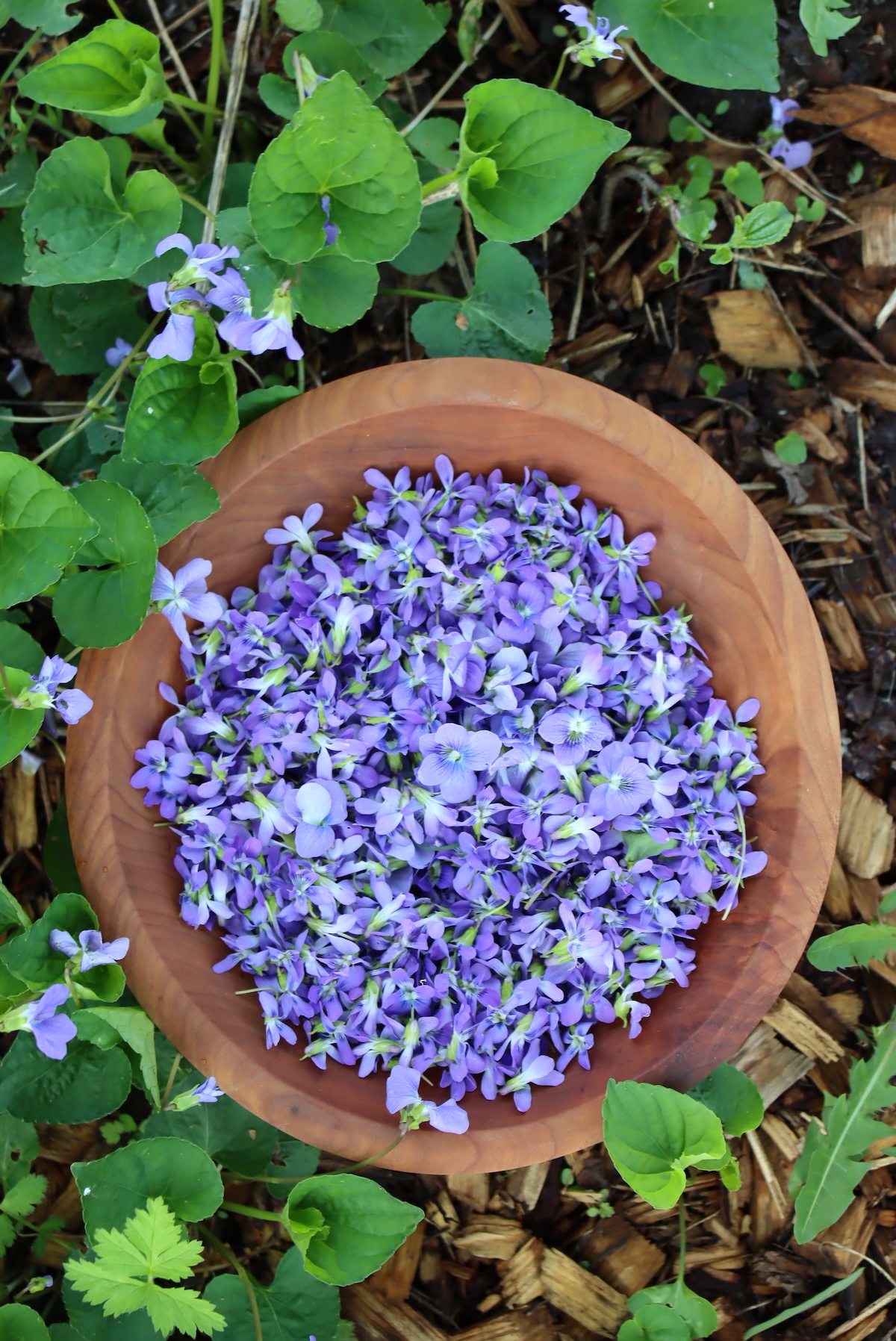
Witch Hazel (Hamamelis virginiana)
Witch hazel is most commonly associated with treating hemorrhoids, but these small trees with fragrant yellow flowers. You find these trees in woody areas, and they often reach up to 30 feet tall. If you get close to this shrub, you might notice an appealing fragrance.
Witch hazel is a well-studied medicinal plant, so we know it has many different properties including anti-inflammatory, antiviral, and anti-cancer properties. Studies also show that witch hazel helps treat skin problems and irritations. (Studies)
Witch Hazel Benefits
The great thing about witch hazel is that we know it has many practical uses. Herbalists regularly use this herb to treat bug bites, hemorrhoids, and skin irritation. It’s a main ingredient in Tuck pads, a common treatment for hemorrhoids, reducing the swelling and inflammation associated with this frustrating condition.
The traditional medicinal uses of witch hazel include:
- Reduce skin inflammation
- Relieves sensitive skin
- Reduces itchiness, pain, and swelling of hemorrhoids.
- Soothes sore throat
Growing & Using Witch Hazel
This perennial shrub reaches 10 to 20 feet tall and equally wide. Witch hazel shrubs prefer full to partial sunlight and loam or silt soil. The shrub prefers acidic to neutral soil, growing well in USDA zones 3 to 9.

Yarrow (Achillea millefolium)
Yarrow is native to North America, and it often grows wild throughout the countryside, along roads, and in various places. Since the plant is quite hardy, it grows in places you might not expect, even on abandoned lots.
This plant has flower heads full of tightly packed flowers in various colors, such as yellow, red, pink, white, or even purple! Yarrow is a perennial plant, and you most often see white flowers on these plants.
Yarrow Benefits
Yarrow has a long history as a medicinal plant. We know that the ancient Greeks used yarrow to treat soldiers’ wounds, and treating wounds is still one of the most common ways to use this plant as poultices and ointments. Studies show that yarrow has antibacterial, anti-inflammatory, and antifungal properties, all of which aid in wound healing.
There are tons of uses for yarrow, and we know if you take it at the onset of cold or influenza symptoms, it helps ease the symptoms of the flu. Since it’s a natural anti-catarrhal and natural fever reducer, it will help you feel better faster.
Here are a few benefits of yarrow.
- Heals skin wounds
- Reduces inflammation
- Helps relieve depression and anxiety
- Treats diarrhea, bloating, and other digestive problems
Growing & Using Yarrow
Yarrow is an easy flower to grow in your garden with various bloom colors, so long as you live in USDA zones 3 to 9. The plant prefers full sunlight to encourage growth; partial shade leads to leggy growth.
Make sure the plant has well-draining soil. Yarrow prefers dry conditions; loamy soil is best for this plant as long as it’s not constantly wet.
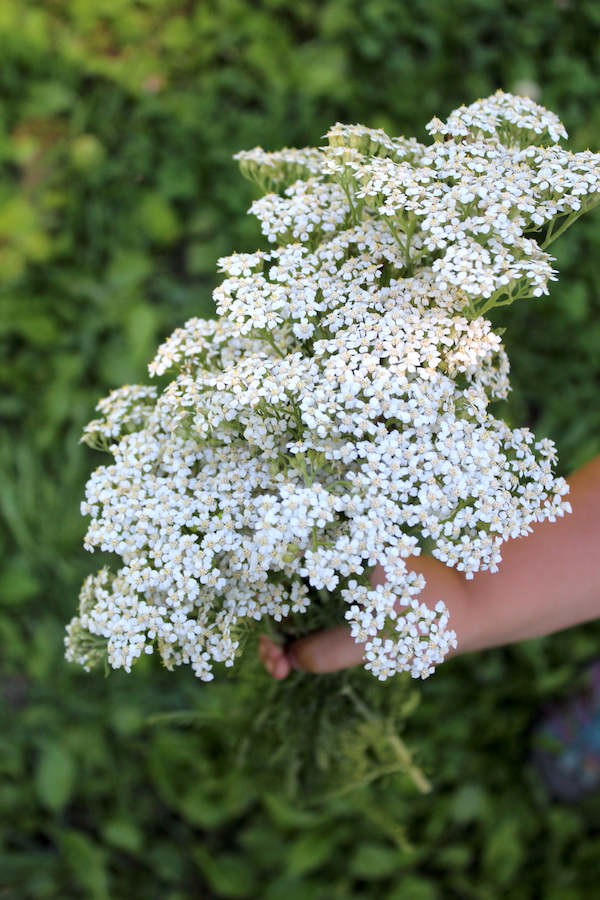
Herbal Disclaimer
Reminder, this guide is only meant to be a starting point to jump-start your own research and encourage more interest in medicinal plants.
I’ve been foraging wild medicines and treating my family with herbal remedies for the past 20 years, but I’m self-taught. Be aware that I am not a clinical herbalist, and this is based on my own research and personal experience using medicinal plants. I do not claim to have the experience that’d qualify me to advise you on your health, and I’m only providing this as a reference to encourage a broader interest in medicinal plants.
Always do your own research and verify anything you read with multiple sources.
It’s always possible to have an adverse reaction to any medicinal herb, and plenty of people are allergic to even gentle herbs like chamomile. Always consult your doctor or a certified herbalist before trying any new medicinal plant. Often, they can have unintended reactions in combination with other herbs and supplements, and many herbs have side effects even when they are effective for their intended purpose.
If you are seriously interested in herbal medicine, I’d suggest investing in a course in herbal medicine, and I’d recommend any of the online courses put out by the Herbal Academy of New England. Specifically, the introduction to herbal medicine course and the family herbalist group of courses.
They also have a mushroom course, covering both medicinal and edible mushrooms, and a Botany and Wildcrafting Course. I’ve taken both and they’re informative, inspiring, and artfully presented.
Herbal Guides
Looking for more herbal medicine guides?
- 100+ Medicinal Plants (& How to Use Them)
- How to Make a Herbal Salve
- How to Make a Herbal Tincture
- How to Make a Herbal Glycerite
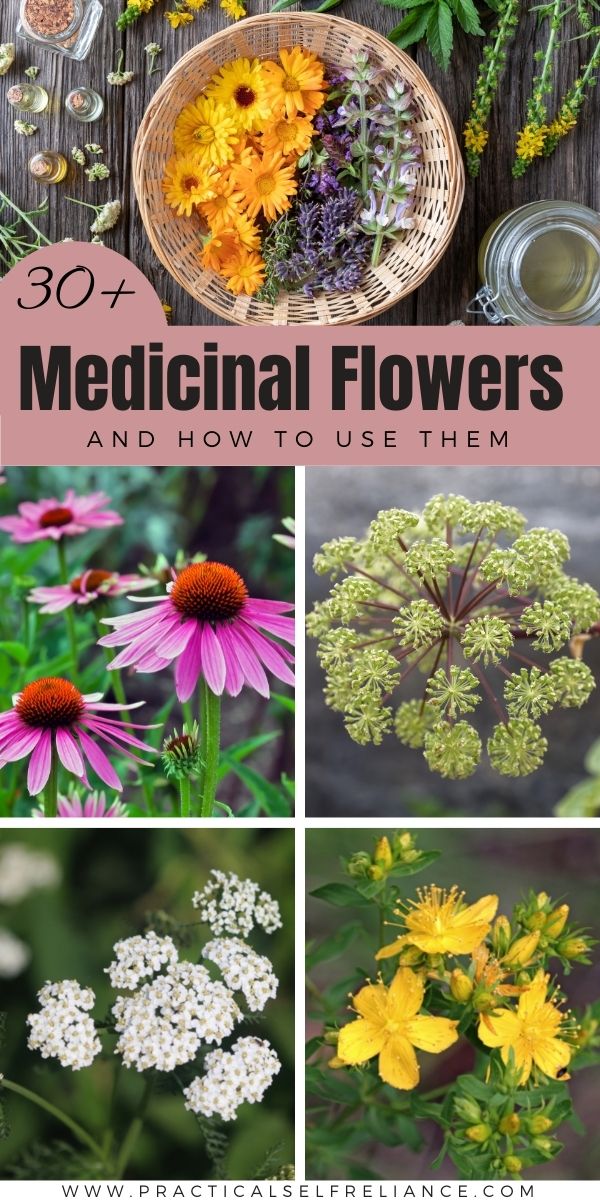
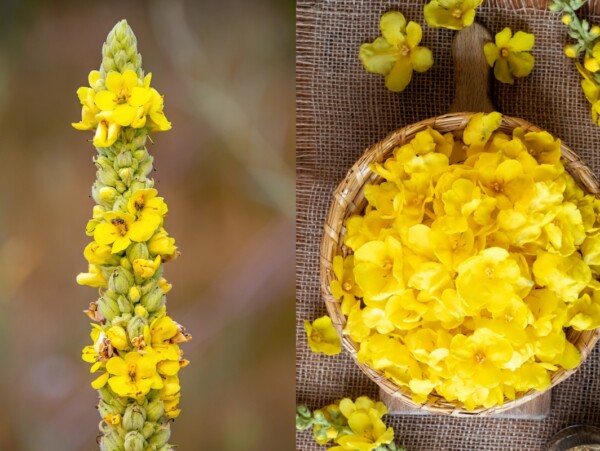
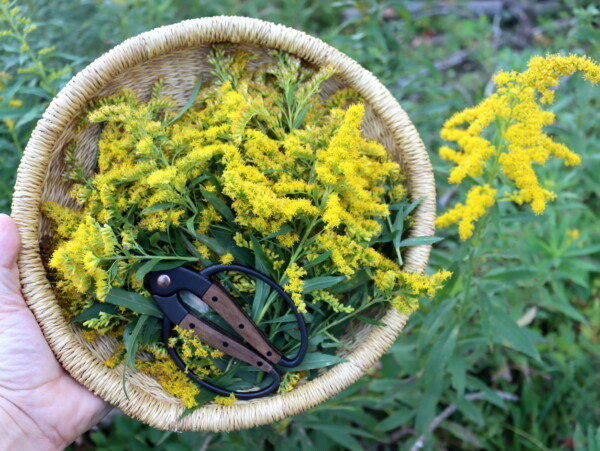
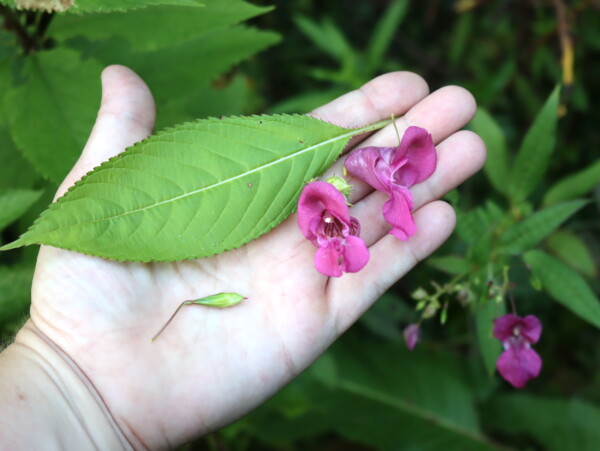
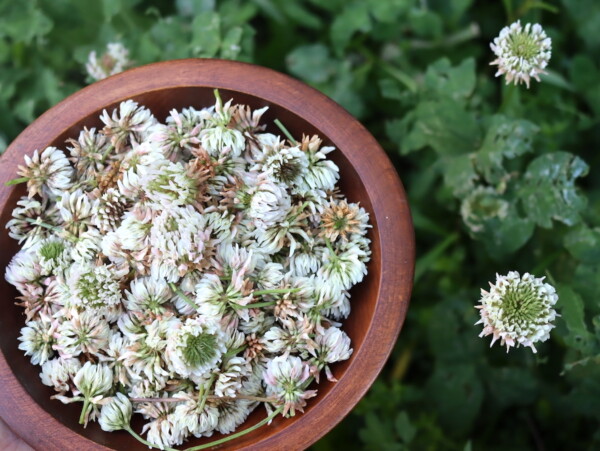
Thank you for this labor of love. This information was comprehensive and so helpful.
You’re very welcome. We’re so glad that you enjoyed the post.
Spectacular article, thanks very much.
You’re welcome.
Such a beauty ful post.. Thanks For Sharing this article..